Bulletin – August 2000 The Economy and Financial Markets
Download the complete Statement 706KB
The Australian economy continued to perform strongly during the first half of 2000, with growth running at more than 4 per cent per annum, a noteworthy performance for an economy that is now entering the tenth year of an economic upswing. In line with the strength of the economy, employment growth has been strong, and unemployment has fallen. At the same time, inflation has picked up, measured either by the CPI or the various underlying measures.
Growth of the Australian economy is being supported by a strong external environment at present and, if anything, global economic conditions have strengthened further in recent months. In the United States, where many observers had been expecting some slowing, growth remained strong in the first half of 2000, while growth in the other major regions has been decidedly firmer. The Japanese economy, which has been the weakest of the major economies in recent years, is now showing signs of recovery. The main uncertainties in the global environment concern the United States, where some slowing in activity is widely expected, and Japan, where the strength and durability of the economic recovery remain uncertain. Nonetheless, the overall condition of the global economy represents an environment that is highly favourable to growth in Australia, with global growth in 2000 likely to be the highest it has been for several years. Growth in Australia's export income over the past year was nearly 30 per cent, a pace which has rarely been exceeded in the past four decades.
It had been expected that as external demand strengthened, domestic spending growth would decline. Several indicators suggested that some areas of private demand had begun to slow in the first half of 2000. But overall demand growth has remained quite strong, boosted to some extent by temporary pre-GST spending, and by public-sector expenditure which, at least as recorded in the national accounts, has also expanded quite quickly. Consistent with this, spending on imports has increased strongly over the past year. The net result is that the broadest economy-wide indicators of activity – GDP and employment growth – have continued to show an economy that is quite robust. This has generated a continuing decline in unemployment, bringing the unemployment rate down to around 6¾ per cent in recent months, its lowest level for a decade.
With the implementation of major changes to tax arrangements from 1 July, a number of economic indicators have already become more difficult to interpret over short periods, and this will continue in the months ahead. The introduction of the GST is likely to have shifted a significant volume of housing activity from the second half to the first half of the year. This is already evident in the recent sharp declines in the forward indicators of housing activity after the strength recorded earlier in the year. There was also a very large boost to some areas of retail spending in June which is likely to be followed by a couple of weaker months. Working in the other direction, some business investment spending may have been deferred to the second half of the year to benefit from the more favourable tax treatment under the new system.
Leaving aside these short-term influences, conditions at present appear conducive to continued strong growth. Exports are increasing rapidly, reflecting the favourable international environment as well as the boost being given by current levels of the exchange rate. This in turn is feeding into growth in domestic incomes. Corporate profitability is high, and businesses have ready access to funding, providing a favourable environment for investment. Developments in household income and wealth remain supportive of consumer spending, and the substantial income tax cuts and increases in government benefit payments implemented recently will provide further support in that area.
Notwithstanding the recent increases in interest rates, the stance of monetary policy is not unduly restricting growth at present. Real interest rates could not be considered high judged by any previous comparable period, and credit has continued to expand rapidly, with the pace of credit growth increasing further in recent months. Strong demand for credit has been particularly evident in the household sector, where debt levels in aggregate have increased by more than 17 per cent over the past year. While such a rate of expansion will clearly not be sustainable in the longer run, there is little sign at this stage that the appetite for borrowing has been restrained by the recent increases in interest rates, even though the higher debt burden of households might be expected to make them more responsive to interest rate changes.
There has been a gradual increase in inflationary pressures during the past year. The CPI rose by 3.2 per cent over the year to June, slightly above the target for CPI inflation of 2–3 per cent. The large CPI rise was partly attributable to some temporary or industry-specific factors, most notably higher international oil prices. Temporary departures from the target inflation rate of this nature are acceptable, as Australia's flexible inflation targeting policy is specifically designed to cater for volatility in the CPI. Various core measures of inflation point also to a gradual increase. These measures suggest core inflation is currently running at around 2½ per cent, compared with around 1½ per cent a year ago. Upstream price indicators are also indicative of an increase in inflation pressures, in part reflecting the depreciation of the exchange rate since late 1999. Some of these cost increases have probably not yet been reflected in final consumer prices.
Price data will become more difficult to interpret in the period ahead because of the significant impact that the changes to tax arrangements are likely to have on the CPI. These will have their main impact in the September quarter but it will be some time before the CPI, or underlying inflation measures based on the CPI, will provide a clear reading of annual inflation unaffected by the tax changes. The Bank has signalled its intention to abstract from these tax effects, and monetary policy will seek to ensure that ongoing inflation excluding the tax effects remains consistent with the target. This will require careful judgments to be made as to the respective contributions of tax effects and ongoing inflation to CPI movements in the quarters ahead. In assessing the inflation outlook the Bank continues to assume that there will be no significant second-round effects on wages and prices flowing from the implementation of the GST. Prospects for avoiding such second-round effects appear to be good at this stage. The Bank's current assessment is that inflation (excluding tax effects) is likely to be in the upper part of the target zone over the next four to six quarters, though inflation risks overall are tilted somewhat to the upside.
Monetary policy has responded to the changing balance of risks to economic activity and inflation, increasing the cash rate in five steps since last November, the most recent of these being in early August. The Board's assessment throughout this period has been that, with strong growth, a gradual increase in underlying inflation, and firming demand for credit, interest rates needed to rise to lessen the risks of higher inflation in the future. The structure of market interest rates has reflected market participants' changing perceptions of the likely course of the economy and of monetary policy's response to it. In the most recent period, following the tightening of monetary policy in May, market interest rates declined for a time as participants assessed that the cumulative tightening over the previous six months might have been sufficient to reduce the risks on inflation. But, in July, this view began to change. With data on economic activity and, more importantly, inflationary pressures on the high side of expectations, market interest rates moved up as participants became conscious of the inflation risks and began to price-in the possibility of a further tightening of monetary policy. By the time of the Bank's early August policy announcement, markets had priced into short-term yields about a 50 per cent probability of a change in policy that month, and close to 100 per cent by the following month. The announcement caused a further modest rise in market yields, and some increase in the exchange rate of the Australian dollar; the share market did not seem to be much affected. Most banks responded soon after with increases in their main lending rates similar to the rise in the cash rate.
Under the inflation targeting framework, the objective of monetary policy remains to contain inflation in the medium term, thereby ensuring one of the pre-conditions for the economy to attain its maximum sustainable growth. In the period ahead, the Bank will continue to evaluate incoming data, with a view to assessing the evolution of the economy and the risks to the outlook.
International Economic Developments
United States
The United States economy maintained considerable momentum over the first half of 2000. Real GDP increased by 1.3 per cent in the June quarter, to be 6 per cent higher than a year earlier (Graph 1). The pick-up in growth over the past year has been driven by a marked increase in domestic final demand. Growth in consumer spending, while remaining high, has softened a little, and growth in residential investment spending has slowed, but these have been more than offset by an acceleration in business investment and government spending. Although export growth has also strengthened over this period, it has been roughly matched by a pick-up in import growth.
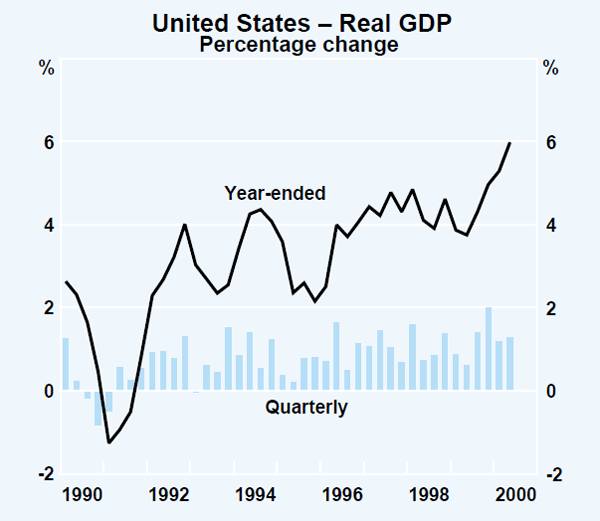
The key question is whether the economy will slow substantially during the second half of the year. Some slowing has been expected, on account of the tightening in financial conditions which has taken place since the middle of last year. To date, the Federal Reserve has increased the Federal funds rate by 175 basis points in this tightening phase, and recent evidence from the Federal Reserve's survey of senior loan officers suggests that lenders are also becoming somewhat more cautious about extending credit to businesses. There has also been some softening in the share market, particularly for technology stocks; the S&P 500 index is currently around 5 per cent below the peak levels reached in March, and the NASDAQ is currently 21 per cent lower.
Overall, however, evidence that the tighter financial conditions are restraining growth is only gradually emerging. It is clearest in the housing sector: housing starts turned down some months ago, and imply that residential investment is likely to fall in the second half of this year. Business sentiment, according to the National Association of Purchasing Managers' survey, has also deteriorated and recent monthly data suggest that underlying employment growth has moderated a little. Although consumption growth slowed back towards trend in the June quarter, it is not yet clear that this slower pace will be sustained. Consumer confidence remains at historically high levels, household income growth remains robust and the level of household wealth relative to current incomes is still high, even given the recent developments in the share market. Aggregate credit growth also remains strong for both the household and business sectors, suggesting that financial conditions are not yet particularly restrictive.
Over the past decade, growth in business fixed investment has outpaced that of the economy more generally (Graph 2). This has been driven by a rapid expansion in equipment investment, which in turn has been driven by the adoption of information technology (computers and software) by businesses, and is arguably one of the factors behind the US economy's recently improved productivity performance. Looking ahead, if businesses expect that the productive gains arising from investing will continue to outweigh the higher cost of financing, investment may continue to grow strongly.
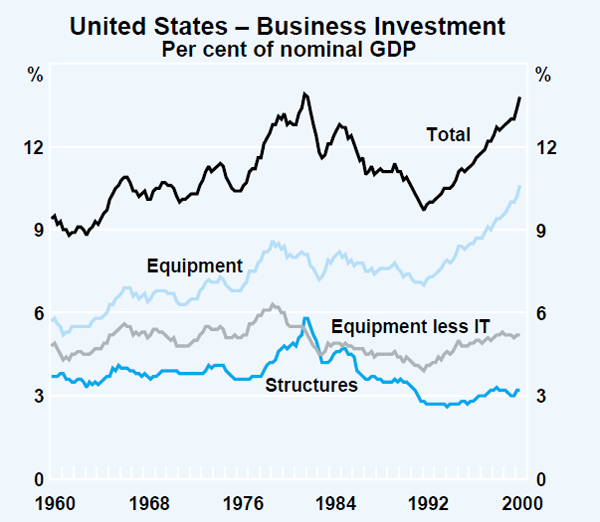
The evidence is clear, however, that underlying inflation has picked up. Core consumer price inflation has risen to around 2½ per cent, from the 2 per cent rate that prevailed through the second half of last year, although it does not appear to be increasing further at this stage. CPI inflation is running noticeably faster than this, at 3.7 per cent, having been boosted by higher oil prices. Several of the favourable developments that helped restrain inflation over the past few years are now dissipating. Following a four-year period of decline, non-oil import prices increased by 1.1 per cent over the year to June and wages growth now looks to have passed its trough. The Employment Cost Index rose by 1 per cent in the June quarter and has increased by 4.4 per cent over the past year, driven by a particularly strong increase in growth in the private sector component. Productivity, however, continues to post solid gains, increasing by 5.2 per cent over the year to the June quarter, and will help to contain growth in unit labour costs.
Japan
Japanese GDP grew strongly in the March quarter, increasing by 2.4 per cent. Growth in the quarter was driven primarily by private spending, with consumption, housing and business investment all rising strongly. Public spending continued to fall in the March quarter, but the fiscal stimulus announced last November is likely to boost growth in coming quarters.
Although the national accounts data have been volatile over recent quarters, a range of indicators suggest that activity is improving gradually. The pick-up in consumption in the March quarter appears to be continuing and is being supported by further increases in consumer confidence; household spending increased by 2½ per cent in the June quarter and consumer confidence is now at its highest level in 4 years (Graph 3). Business confidence also strengthened in the June quarter according to the Tankan survey, and firms expect this trend to continue into the second half of the year. The improvement in confidence has been greatest for manufacturing firms, which have benefited from the strong pick-up in external demand: exports increased by 8 per cent over the past year. Manufacturers have thus progressively revised up their investment intentions, and are now looking to increase investment in the year to March 2001 for the first time in two years. In comparison, non-manufacturing firms still expect to reduce their investment spending over this period.

These improved demand conditions have been reflected in the output data. The Ministry of International Trade and Industry's index of overall business activity consolidated its strong increase in the March quarter, and increased by 2.3 per cent over the year to May. Both industrial production and service sector output contributed to this increase, continuing the positive trends prevailing since early last year.
While the prospects for the Japanese economy appear to be improving, some short-term risks to the recovery remain. Despite recent strength, consumer demand is perhaps the greatest area of uncertainty, and the weakness of labour market conditions will not help in this regard. Wages growth remains weak and employment is 0.2 per cent lower than a year ago. Evidence from the Tankan survey indicates that while there has been some improvement in firms' hiring intentions, firms still perceive current employment levels to be excessive.
Consumer prices continue to fall, and are 0.7 per cent lower than a year ago. While the sizeable output gap has significantly contributed to this outcome, other factors have also been important: non-oil import prices have been declining (in line with the exchange rate appreciation), deregulation in the service sector has dampened prices, and food prices have been lowered by favourable weather conditions. Higher oil prices have partly offset these factors.
Non-Japan Asia
Activity in non-Japan Asia remained strong during the first half of 2000, though the pace of growth varied widely across countries; over the past year, growth has been strongest in Hong Kong, Korea and Malaysia and weakest in Indonesia (Table 1). Until recently, the growth in output in the region was driven primarily by the external sector. Strong export growth has continued, but there has also been a pick-up in domestic demand in a number of economies in the region, reflecting increases in both consumer spending and, in a few cases, investment (Graph 4). Domestic demand has been supported by an improvement in labour market outcomes, with unemployment generally falling across the region.
| March qtr | Year to March qtr |
Net change since June 1997 |
|
|---|---|---|---|
| Hong Kong | 5.3 | 14.3 | 7.0 |
| Indonesia | 4.8 | 3.6 | −8.9 |
| Korea | 1.8 | 12.6 | 9.4 |
| Malaysia | 5.7 | 11.7 | 6.3 |
| Philippines | 0.0 | 3.4 | 4.2 |
| Singapore | 3.1 | 9.2 | 11.6 |
| Taiwan | 2.3 | 7.9 | 17.2 |
| Thailand | 1.5 | 5.2 | −5.0 |
| Non-Japan Asia | 2.8 | 9.2 | 6.1 |
|
Source: CEIC database |
|||
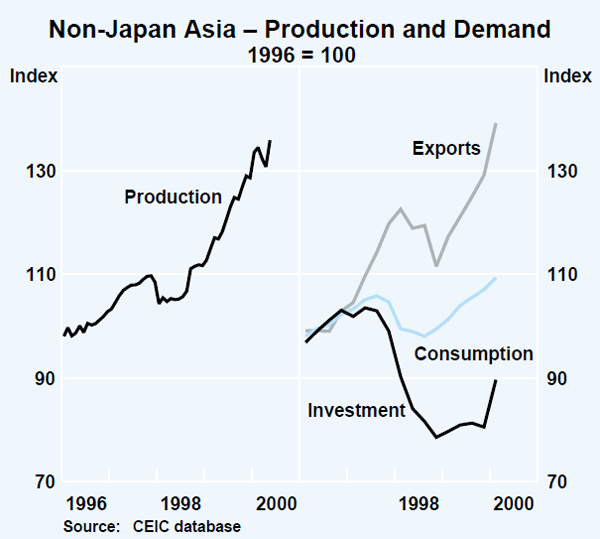
Through most of this recovery, the weakest component of demand in non-Japan Asia has been investment. This has particularly been the case in those countries that were worst hit by the Asian crisis, such as Indonesia and Thailand. More recently, however, investment has rebounded sharply in several countries. While construction investment continues to be weighed down by the ongoing weakness in property markets throughout the region, the strength in the region's exports has led to the need for increased equipment investment in export-focused industries, despite the existence of excess capacity in other sectors.
Export growth has been driven by the ongoing strength in world demand, as well as the rebound in domestic demand within the region, as noted above. While exports to all major destinations have grown solidly, intra-regional trade and exports to Japan have increased particularly strongly of late. Export growth has also been fairly broadly based across all major categories of goods, although electronics exports remain especially strong.
Despite the increase in world oil prices, consumer price inflation in non-Japan Asia remains subdued, with inflation at or below 2 per cent in most countries, a good deal below pre-crisis rates (Graph 5). This has enabled monetary policies to remain generally supportive of growth.
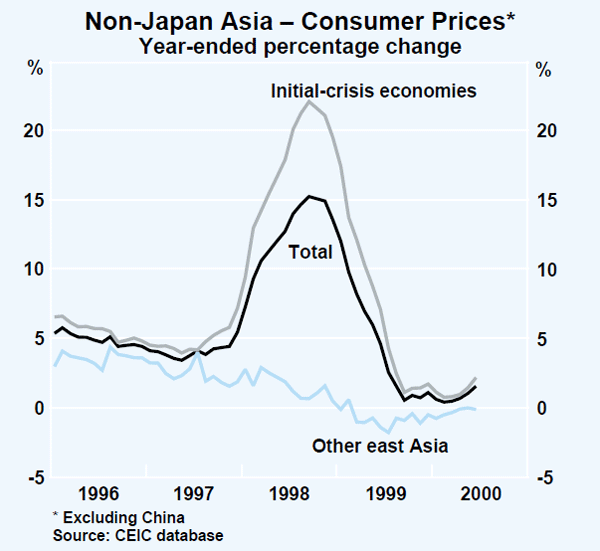
While significant progress has been made on financial restructuring in the crisis-affected countries, much work remains to be done. Significant amounts have been spent recapitalising weak financial institutions and removing non-performing loans from the financial sector, mostly through the use of government-supported asset management companies (Table 2). However, the proportion of these problem loans actually resolved remains small. The collapse of Daewoo in Korea in mid 1999 and the associated problems in the investment trust industry, as well as the suspension of three merchant banks this year, highlight the weakness that remains in Korea's financial sector and the potential risks to the region moving forward.
| Indonesia | Korea | Malaysia | Thailand | |
|---|---|---|---|---|
| Before transfer to asset management companies | 31.4 | 17.9 | 24.0 | 41.0 |
| After transfer to asset management companies | 12.4 | 10.1 | 17.5 | 38.5 |
|
Source: World Bank, East Asia: Recovery and Beyond, May 2000 |
||||
Less progress has been made on corporate restructuring in the region. Most emphasis here has been on voluntary restructuring which has come up against considerable resistance. A recent report by the World Bank suggests that in Korea, Malaysia and Thailand, at least one-quarter of firms listed on the stock exchange were not able to meet their interest payments from operational cash flows in 1999; this proportion was close to two-thirds in Indonesia.
Real GDP in New Zealand rose by 0.8 per cent in the March quarter to be 5½ per cent higher than a year earlier. Domestic demand growth was noticeably weaker in the quarter, following very strong growth through 1999, while the contribution to growth from net exports picked up. Although output growth remains strong, the labour market has been subdued; employment fell slightly in the June quarter, to be 1 per cent higher than a year earlier. Looking ahead, domestic demand growth may be tempered by the weakening in both business and consumer confidence that has taken place in recent months, though offsetting this, the lower level of the NZ$ should continue to support strong growth in the external sector.
Inflationary pressures have increased over the past year. The consumer price index increased by 0.7 per cent in the June quarter, to be 2.0 per cent higher than a year earlier, in part reflecting the increase in oil prices. Upstream price pressures have also been boosted by the rise in oil prices, as well as the depreciation of the exchange rate and the increase in world commodity prices; producer input and output prices have increased more sharply over the past six months than they have since the early 1990s. The Reserve Bank of New Zealand has increased the Official Cash Rate by 200 basis points since November, to 6.5 per cent.
Europe
The economic outlook remains favourable in the euro area with output increasing firmly in the March quarter, to be 3.4 per cent higher over the year (Graph 6). The depreciation of the euro and strong world growth has provided a fillip to domestic producers with exports increasing strongly over the past year. The pick-up in growth has helped boost employment, with the unemployment rate falling to 9.1 per cent in June, the lowest rate since mid 1992. Steady employment and wages growth have helped underpin household incomes and provided support for continued growth in consumption. Positive conditions in the euro area are also reflected in both consumer and business confidence, which are now at or around record highs.
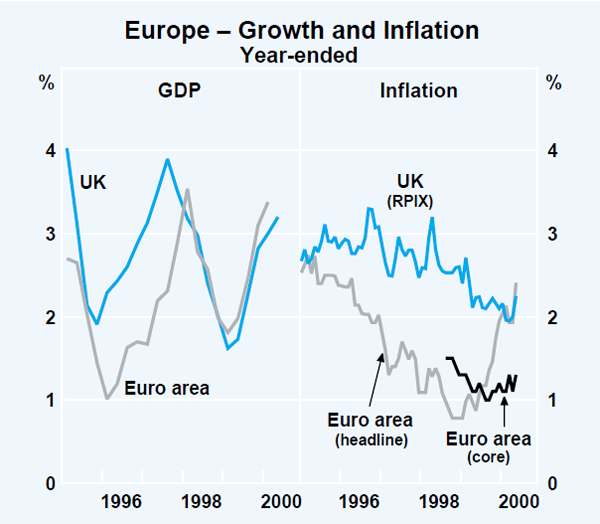
Although core inflation – at 1.3 per cent – remains subdued, headline inflation picked up sharply in June to be 2.4 per cent. Currently, ten of the eleven EMU countries have headline inflation above the euro area target rate of 2 per cent. The European Central Bank (ECB) raised its key refinancing rate by 50 basis points to 4.25 per cent in early June. The ECB has raised interest rates five times, and by 175 basis points, since last November, expressing concern that the recent increase in imported goods prices, driven by both the depreciation of the euro and the pick-up in oil prices, poses risks for price stability over the medium term.
The UK economy strengthened in the June quarter, with real GDP increasing by 0.9 per cent, compared with growth of 0.5 per cent in the preceding quarter. This pick-up reflected stronger growth in both industrial production and service sector output. Nevertheless, survey evidence suggests that growth may begin to moderate moving forward, in line with a slowing in domestic demand. Consumer price inflation (excluding mortgage interest payments) was 2.2 per cent over the year to June, boosted by around three quarters of a percentage point by higher oil prices.
International Financial Markets
International financial markets have been in something of a holding pattern in recent months as they assessed the implications of increases in official interest rates in virtually all developed countries over the previous 6–12 months. Rises in official interest rates have been in the order of 1–2 percentage points across countries, with most in the top half of this range.
The United States Federal Reserve has raised the Fed funds target by 175 basis points, to 6.50 per cent, in the current monetary tightening episode which began in June last year (Graph 7). The first five increases were each of 25 basis points, but the latest increase, in May, was 50 basis points. This followed the release of data suggesting that wage and inflationary pressures may be building.

Among other English-speaking countries, the Bank of England has increased official rates by 100 basis points in four steps to 6 per cent, the Reserve Bank of New Zealand has increased rates by 200 basis points to 6.5 per cent, and the Bank of Canada has increased rates by 125 basis points to 5.75 per cent, with the past four increases immediately following the US Fed (Table 3).
| April | May | June | July | August | Cumulative increase since mid 1999 |
Current level (%) |
|
|---|---|---|---|---|---|---|---|
| US | 50 | 175 | 6.50 | ||||
| Canada | 50 | 125 | 5.75 | ||||
| Australia | 25 | 25 | 25 | 150 | 6.25 | ||
| NZ | 25 | 50 | 200 | 6.50 | |||
| UK | 100 | 6.00 | |||||
| Euro | 25 | 50 | 175 | 4.25 | |||
| Denmark | 25 | 60 | 185 | 4.70 | |||
| Sweden | 85 | 3.75 | |||||
| Switzerland | 175 | 3.50 | |||||
| Norway | 25 | 50 | 25 | 8.25 |
While economic expansions in the continental European economies are at a less advanced stage than those in the English-speaking economies, monetary authorities there also have generally increased interest rates, though the levels remain below those in the latter countries. The European Central Bank has increased official rates by 175 basis points to 4.25 per cent, while Denmark's central bank has increased rates by 185 basis points to 4.7 per cent. The Swedish central bank has increased policy rates by 85 basis points to 3.75 per cent, while the Swiss authorities have increased their target band by 175 basis points to between 3 and 4 per cent.
Japan remains an exception to the tightening cycle. With economic conditions in Japan improving in recent months, the Bank of Japan had begun to prime markets for an end to its zero interest rate policy at its 17 July meeting but, in the event, the collapse of a large Japanese retailer, Sogo Co, prompted the Bank to hold off its decision. Markets see this as no more than a temporary delay.
Since the last round of official interest rate increases around the world over May and June, market interest rates in many countries have fallen as earlier inflationary fears have subsided. In the US, yields on 10-year bonds have settled around 6 per cent compared with a peak of around 6.5 per cent. The yield on the German 10-year bond has fallen from around 5.45 per cent to 5.20 per cent. UK yields have fallen by a similar amount. The main exception to this global pattern has been Japan, where 10-year bond yields have remained remarkably stable, generally trading in the range between 1.7 per cent and 1.8 per cent so far this year (Graph 8).
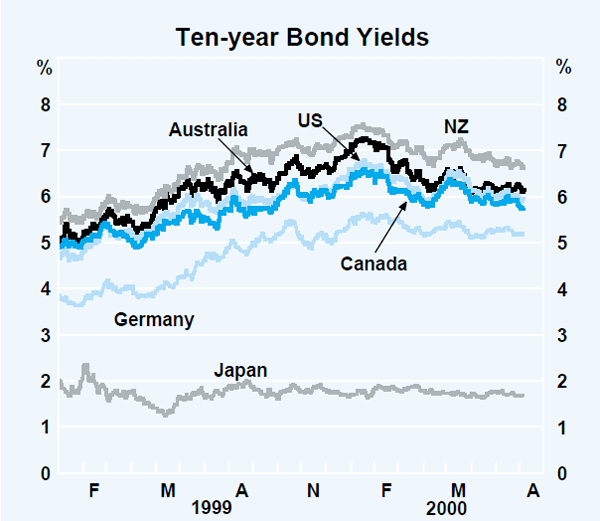
As policy rates were increased in the US over the first few months of 2000, share markets became increasingly prone to volatility, culminating in a large correction over April and May (Graph 9). Markets with relatively high weightings in the technology sector were the hardest hit. The Nasdaq index fell by 25 per cent over this period.
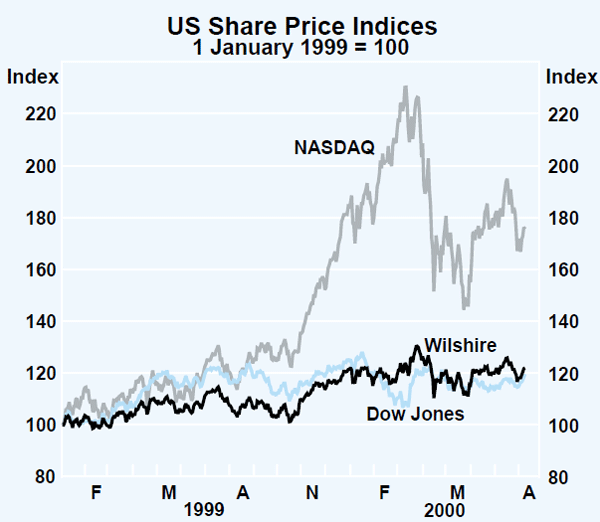
Share prices recovered for a time in June as markets began to anticipate a ‘soft landing’ of the US economy, but more recently share prices have again been subject to weakness as profit announcements by companies have generally disappointed. Broad-based share indices in the US have now shown little net change so far this year (Table 4).
| Jan 1999 to current |
Jan 2000 to current |
Current change from 2000 peak |
Current change from 2000 trough |
|||
|---|---|---|---|---|---|---|
| Wilshire | 21 | 0 | (24 Mar) | −7 | (14 Apr) | 11 |
| Dow Jones | 20 | −5 | (14 Jan) | −6 | (7 Mar) | 12 |
| S&P 500 | 21 | 1 | (24 Mar) | −3 | (5 Feb) | 11 |
| NASDAQ | 76 | −5 | (10 Mar) | −24 | (25 May) | 22 |
Share markets in most other countries have followed a similar course, with those with relatively higher weightings of technology stocks – such as Germany and Canada – having been more volatile (Graph 10).

Japanese share prices remain well below their early 2000 peaks. Following sharp falls in April and May which were part of the world-wide correction at that time, the Japanese market has remained under pressure amid some increase in corporate bankruptcies and rising prospects of some increase in interest rates.
The factors driving interest rates and share markets in recent months have also had an impact on exchange rates among the three major currencies. The trade-weighted value of the US dollar appreciated sharply over April and into May as inflationary concerns rose and markets anticipated a more aggressive monetary tightening by the Fed. It depreciated for a time as these concerns receded, but, more recently, has tended to rise again (Graph 11). This cycle was most pronounced against the euro (which fell to a record low against the US dollar in May) but was also evident to a degree in the rate against the yen (Graph 12).
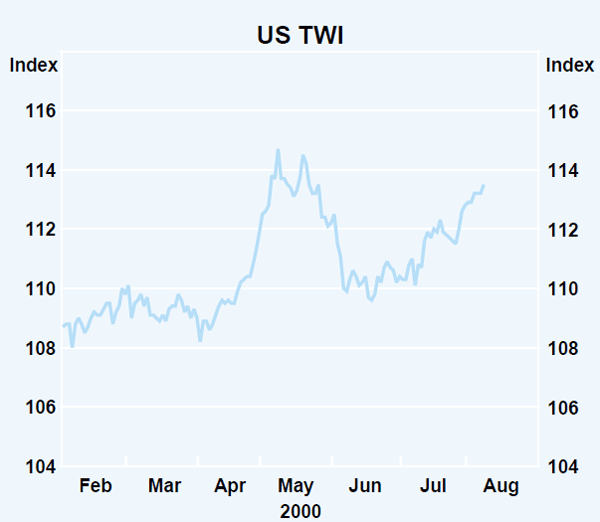
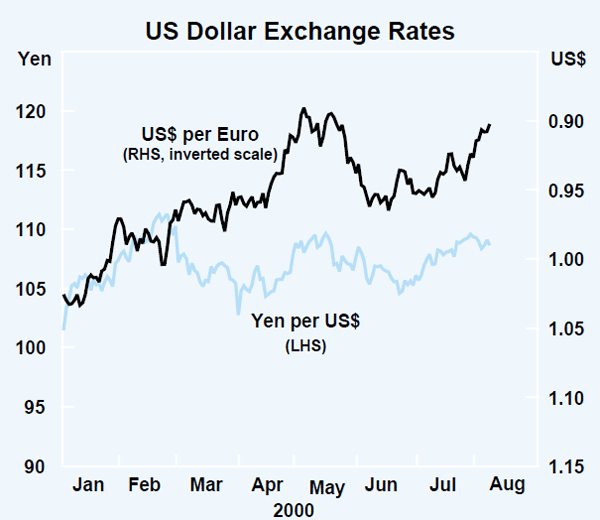
Most of the Asian economies with freely floating currencies have experienced some exchange rate falls against the US dollar in recent months. This was particularly the case for Thailand, Indonesia and the Philippines and mainly seemed to reflect concerns by international investors about whether their recent pace of economic expansion could be sustained. The falls were fairly modest (in the order of 5 per cent) and well within the fluctuations that could be expected of floating exchange rates. The earlier strong upward pressure on the Korean won, which had been resisted by the Bank of Korea through intervention, also seems to have abated in recent months.
Domestic Economic Activity
The Australian economy continued to grow strongly in the first half of the year (Graph 13). Over the year to the March quarter, real output growth again exceeded 4 per cent, and indicators point to further strong growth in the June quarter. In the past few quarters, the composition of growth has gradually shifted, with a slight slowdown in the pace of consumption growth offset by an increase in export growth, in line with the strengthening world economy. The lower exchange rate, favourable domestic financial conditions and the boost to household incomes from income tax cuts and increases in social benefit payments should continue to support growth in the period ahead.
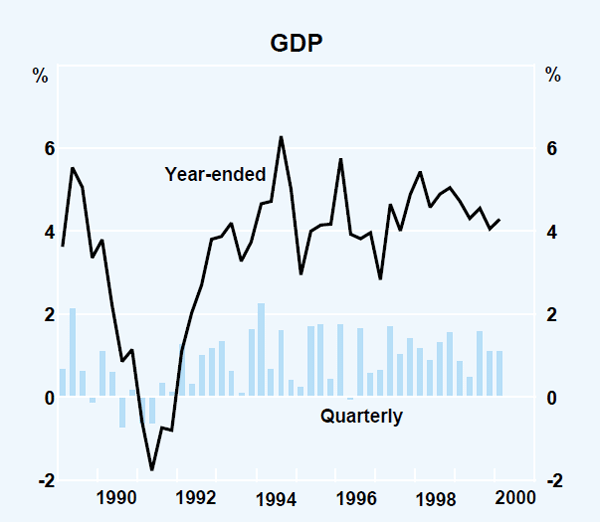
The strength of growth in the March quarter as measured in the national accounts was at odds with some of the partial indicators which had suggested that a noticeable slowdown was in train. However, it was consistent with a number of underlying economic factors supportive of growth. Robust household income growth bolstered by strong employment growth, fast credit growth and a high level of household wealth have underpinned the strength in consumption. The ready availability of funding and the high level of profits have contributed to a favourable environment for business. These factors appear to have offset any dampening influence from the declines in business and consumer confidence that occurred in the March quarter. More recently, as discussed below, the decline in consumer confidence has been reversed.
The changes to the tax system have affected some parts of the economy prior to their implementation on 1 July. This has been most evident in the housing sector, which was operating at full capacity in the March and June quarters. The tax changes also influenced consumption decisions with the purchase of some goods whose prices were expected to increase on 1 July being brought forward before that date, and other purchases where prices were expected to fall – most notably motor vehicles – being delayed. Some investment spending is likely to have been delayed until the September quarter to take advantage of lower prices, though this has been offset to some extent by businesses needing to invest in systems in preparation for the introduction of the goods and services tax and the new business reporting requirements.
The coincidence of the effects arising from the changes to the tax system and the Olympic Games in September will make interpreting developments in the economy, especially the monthly data, more difficult than usual over the near term. In aggregate, the introduction of the GST is likely to have resulted in a transfer of private demand from the September quarter to the June quarter, but the Olympics should provide an offsetting boost to consumption (from ticket sales) and service exports in the September quarter.
Household consumption
The national accounts showed continued growth in consumption spending, though at a slower pace, in the March quarter, after strong growth in the previous six months (Graph 14). This was in marked contrast to the retail trade figures which showed a sharp decline in spending in the March quarter. It is difficult to understand why the retail trade figures showed this result, but part of the answer may be in the pattern of consumption spending. There was reduced spending on retail goods, particularly sales of food, clothing and footwear, and motor vehicles, which was more than offset by increased spending on a variety of services, particularly transport, recreation and culture, hotels and cafes and utilities.
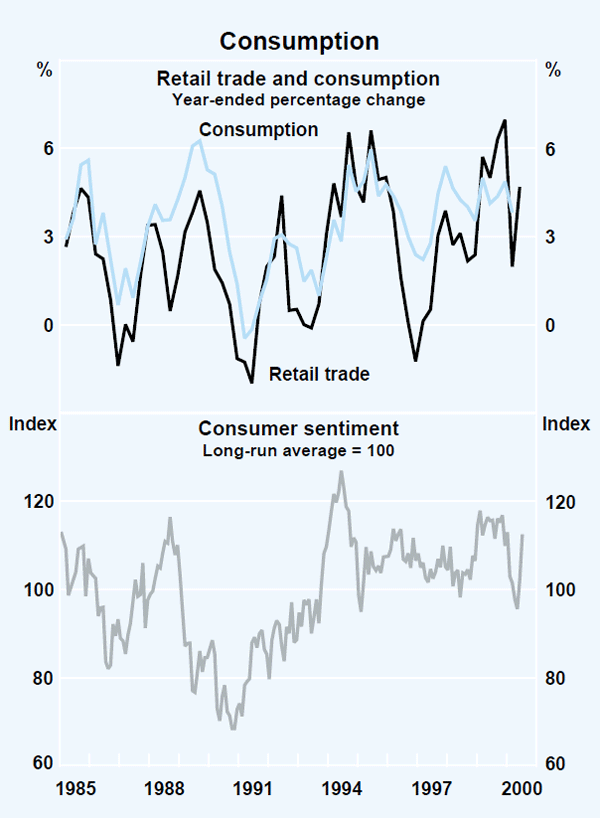
According to the monthly retail trade survey, retail sales remained relatively subdued (especially for the smaller, more specialised establishments) in April and May but rose very strongly in June. For the June quarter as a whole, sales increased in real terms by 2.7 per cent. This increase was experienced across all states, with particularly strong growth in the ACT, New South Wales and Western Australia (Table 5). While developments in income and wealth have been supportive of consumption spending, two additional factors are likely to have contributed to the rise. Firstly, a number of major retailers brought forward their half-yearly clearance sales from July into June. Secondly, consumers became more aware of the likely price changes resulting from the changes to the tax system through price listings such as those released by the ACCC in late May. The retail sales data for June suggest that consumers were, by then, generally well informed of the price changes, with large increases recorded in sales of goods that were expected to rise in price, such as clothing and footwear. Given the change in timing of the half-yearly sales and the pre-GST surge in spending, retail sales are likely to have been temporarily weaker in July.
| March quarter 2000 |
June quarter 2000 |
Year to June quarter 2000 |
|
|---|---|---|---|
| New South Wales | −1.1 | 3.4 | 4.5 |
| Victoria | −3.1 | 2.1 | 2.8 |
| Queensland | −0.6 | 1.8 | 5.1 |
| South Australia | −1.3 | 2.2 | 6.4 |
| Western Australia | −0.1 | 3.6 | 6.7 |
| Tasmania | −1.6 | −0.4 | −0.7 |
| Northern Territory | −0.6 | 2.9 | 6.0 |
| ACT | 2.1 | 8.9 | 16.0 |
| Australia | −1.4 | 2.7 | 4.7 |
In contrast to the surge in retail sales in June, households tended to delay their purchases of motor vehicles until after 30 June when the price of cars was expected to fall and a number of new models were launched on the Australian market. Passenger motor vehicle registrations fell by 13 per cent in the June quarter and were 17 per cent lower than a year earlier. Motor vehicle retailers and wholesalers acted to offset some of the expected downturn by offering discounted prices prior to 1 July. The motor industry's expectation of stronger sales in the second half of the year is evident in the rapid growth of motor vehicle imports in the June quarter. This is consistent with indications of a strong rebound in sales in July.
The Westpac–Melbourne Institute index of consumer sentiment fell sharply in the early months of the year reaching a trough in May below its long-run average. The tightening in monetary policy is likely to have contributed to this decline, but the available evidence indicates that uncertainties about the tax package also had some effect. The Melbourne Institute's ‘Monitoring the GST’ surveys suggested that around 70 per cent of respondents either expected no compensation or didn't know whether they would receive any compensation. The rebound in consumer sentiment may have reflected the fact that the early experience with the GST was less traumatic than most had expected.
Growth in household incomes has supported consumption and should continue to do so in the period ahead, as employment and wages continue to grow solidly. Incomes have been boosted by the income tax cuts and increases in social benefit payments delivered on 1 July. The demutualisation of NRMA may also provide a small boost to household spending, although the payment of the final instalment of the second Telstra float in November may have a negative short-term effect on household cash flows.
In recent quarters, the increase in household wealth has also contributed to the robust pace of consumption spending. Although gross household wealth fell slightly in the March quarter, it remained 12 per cent higher than a year earlier, and 40 per cent higher than three years earlier (Table 6). The decline in wealth in the quarter primarily reflected falls in dwelling prices in Sydney and Melbourne. Dwelling prices nonetheless remain at high levels. They have increased over the past year in all mainland state capitals and in the non-metropolitan regions of all mainland states except Queensland.
| Level $b | Share of total assets |
Year-ended growth |
Average annual growth since March 1997 |
|
|---|---|---|---|---|
| Per cent | ||||
| Dwellings | 1,602 | 55.6 | 13.6 | 13.2 |
| Consumer durables | 122 | 4.2 | 4.3 | 3.3 |
| Financial assets | 1,159 | 40.2 | 10.3 | 11.0 |
| of which: | ||||
| – Currency and deposits | 247 | 8.6 | 2.0 | 4.8 |
| – Equities | 226 | 7.8 | 14.1 | 24.8 |
| – Superannuation and life offices | 606 | 21.0 | 14.1 | 11.2 |
| – Other | 81 | 2.8 | 0.9 | 1.2 |
| Total assets | 2,882 | 100.0 | 11.8 | 11.8 |
|
Sources: ABS; CBA/HIA Housing Reports |
||||
Household sector financial assets increased by 1.7 per cent in the March quarter, a somewhat slower rate than in previous quarters, as a reduction in the value of direct equity holdings partially offset strong gains in the value of funds held in superannuation. Valuation effects, largely due to falls in the prices of bank shares, reduced the value of the household sector's directly owned share portfolio by 1.4 per cent in the March quarter, but these shares have since rebounded in value.
On the other side of the household balance sheet, the debt of the household sector has continued to grow rapidly, increasing by 14½ per cent over the year to March. This has primarily been driven by borrowing for housing, but growth in personal credit has also been strong. The rise in interest rates over the past seven months has not yet had a discernible impact on the borrowing of the household sector, with strong credit growth continuing in the June quarter.
The tightening in monetary policy has, however, resulted in a rise in the interest payments of the household sector from around 6 per cent of household disposable income in the first half of 1999, to around 7¼ per cent in the March quarter (Graph 15). The interest repayment burden on the household sector is now higher than the previous peak in 1996, of 7 per cent of disposable income, reflecting the rapid rise in household indebtedness. This is despite the fact that interest rates paid on debt by households are substantially lower now than in 1996. The interest repayment burden is likely to have increased further in the June quarter as household credit continued to increase at a faster pace than disposable income, and mortgage rates rose. The extent to which this is impinging on household cash flows is less clear. The practice of holding total repayments (i.e. interest plus principal) steady while interest rates fell in 1996 and 1997 appears to have been widespread. This built up a buffer of ‘excess’ repayments which will have cushioned some households from the direct effects of the recent interest rate increases.
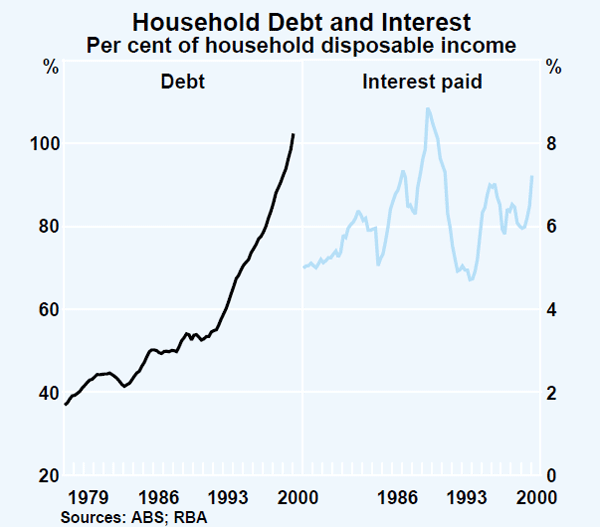
Dwelling investment
While the growth in households' spending on retail goods eased early in the year, spending on dwellings increased significantly. Private dwelling investment grew by 10 per cent in the March quarter and by almost 14 per cent over the previous year, and now accounts for over 6 per cent of GDP, the highest in over twenty years (Graph 16). Although a large part of this activity probably reflects the desire to complete construction prior to the introduction of the GST, other factors have contributed to the strong demand for housing, notably the relatively high levels of affordability throughout 1999. More recently, increases in house prices and interest rates have reduced home affordability.
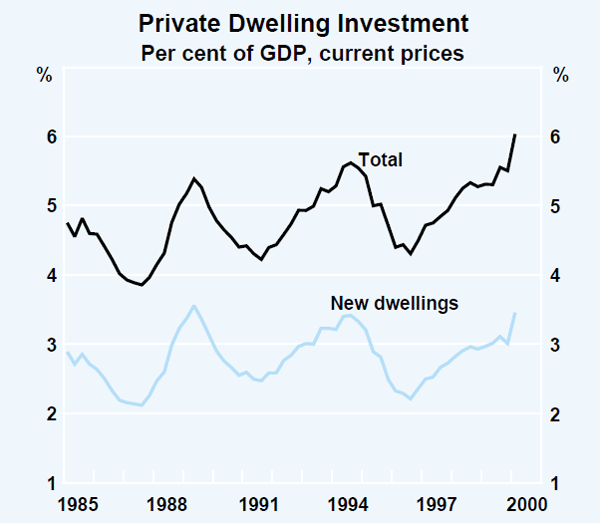
Leading indicators of dwelling activity began to decline as the opportunity to complete work prior to the introduction of the GST diminished. Although the value of loan approvals increased in May, the average level of loan approvals for the three months to May was 11 per cent below the level in late 1999. For owner-occupiers, the largest declines have been in approvals for new construction. In contrast, loans to investors for both new construction and existing houses (a sector likely to have been less affected by the introduction of the GST) have continued to grow at double-digit rates in year-ended terms. Building approvals have fallen sharply in recent months to be nearly 40 per cent below the January peak, although this follows a strong rise of 17 per cent over the previous six months. The largest falls in building approvals in recent months have been in Queensland, South Australia and Victoria. It remains to be seen how much of the large fall in building approvals in June will be reversed following the actual implementation of the GST and the availability of the First Home Owners' Scheme (discussed below).
Notwithstanding the unwinding of the effect of the GST on the housing industry, shortages of labour and materials and the large amount of work yet to be done at the end of the March quarter means that a lot of pre-GST related work will probably spill over into the second half of 2000 (Graph 17). In addition, dwelling activity in the second half of the year is likely to be boosted by policies to assist first home buyers. The most recent loan approvals data showed a declining share of housing commitments going to first home buyers in the lead-up to the GST. Given the extra time taken to complete work prior to the introduction of the GST, there was an incentive for first home buyers to wait and be eligible for the Commonwealth Government's grant to first home buyers of $7,000. In New South Wales, further savings for first home buyers of up to $5,000 in stamp duty exemptions were available from 1 July.
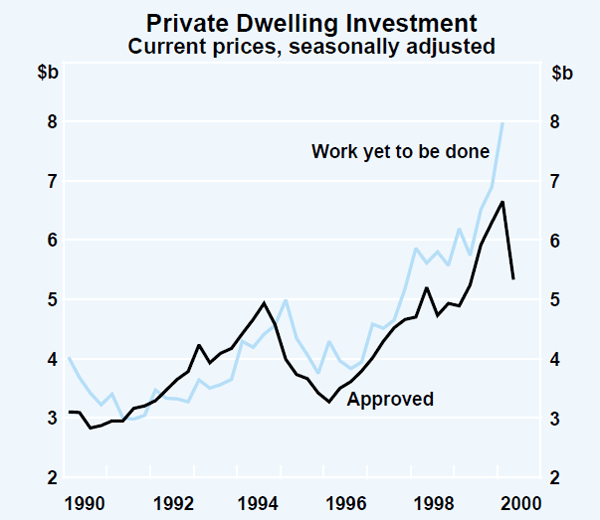
Despite the sharp fall in housing loan approvals, growth in the stock of housing credit has continued to accelerate. Housing credit grew at an annual rate of just under 19 per cent over the first half of 2000, compared with 16¼ per cent over the previous six months. The divergence between housing credit growth and loan approvals may partly reflect lags between the purchase of a home and final settlement. Repayments of principal could also slow in the months immediately following an increase in interest rates, if borrowers who were making more than the contractually required repayment chose to maintain their total repayment as interest rates rose, thereby allowing the amount of principal repaid to fall.
In addition, the capacity constraints in the building sector in the lead-up to the introduction of the GST may have resulted in borrowers obtaining finance for construction well before the work was completed and paid for. Accordingly, a substantial pool of undrawn commitments built up over the last few months of 1999 and the beginning of this year, peaking at a level equivalent to just under 8 per cent of housing credit. In recent months, the flow of loans actually advanced has risen sharply, which may reflect borrowers drawing down their loans in order to finalise payments for their dwellings. The stock of loan commitments not advanced still remains at very high levels, suggesting that housing credit growth is likely to remain high over the next quarter as construction work begun before 1 July is completed and paid for.
The business sector
A favourable external environment, continued strong growth in domestic demand, high profitability and the ready availability of external funds have underpinned a positive environment for the business sector. In the March quarter, strong growth in output was particularly evident in the construction, mining and agricultural sectors. Pre-GST activity boosted output in the construction industry and, given the large amount of work yet to be done in the residential sector, this should support activity in the industry in the period ahead. The addition of new supply capacity in the oil industry, reflecting earlier investment, boosted growth in the mining sector in the March quarter. The strength was not confined to oil, with other areas of the mining sector such as base metals also experiencing strong growth in output through the year.
Profits continued to grow strongly in the March quarter, with the gross operating surplus of the corporate sector increasing by just under 9 per cent, and by 11¾ per cent over the year to the March quarter. As a share of GDP, corporate profits reached 16 per cent in the quarter (Graph 18), the highest recorded ratio, although this has been boosted in recent years by privatisations and the trend towards incorporation by small businesses. Strong profitability, low interest rates and a debt burden well below historical peaks have all tended to hold down the interest burden of the corporate sector: as a share of gross operating surplus, net interest paid by the corporate sector remains well below historical averages.

In addition to the internal funds generated by strong profit results, businesses have ample access to external sources of funding. Business credit has accelerated in recent months, growing at an annual rate just under 13 per cent over the first half of 2000, compared with 4¾ per cent over the previous six months. Both fixed and revolving credit increased, with promissory notes particularly strong for much of this period. The strength in intermediated business borrowing has been reinforced by a high level of non-intermediated debt raisings. Although some share market floats were cancelled or postponed following the decline in share prices earlier in the year, the subsequent rebound in prices should limit any weakness in equity raisings.
Despite these favourable conditions, businesses reported a deterioration in sentiment early in the year which continued into the June quarter, according to the NAB Quarterly Business Survey (Graph 19). This reflected a combination of concerns about the implementation of the tax changes, the impact of higher oil prices on profit margins, as well as higher interest rates. While the deterioration was reported by firms of all sizes, small firms reported the weakest conditions. The mining industry was a notable exception to the fall in business conditions, reflecting the favourable combination of rising commodity prices and strong external demand.
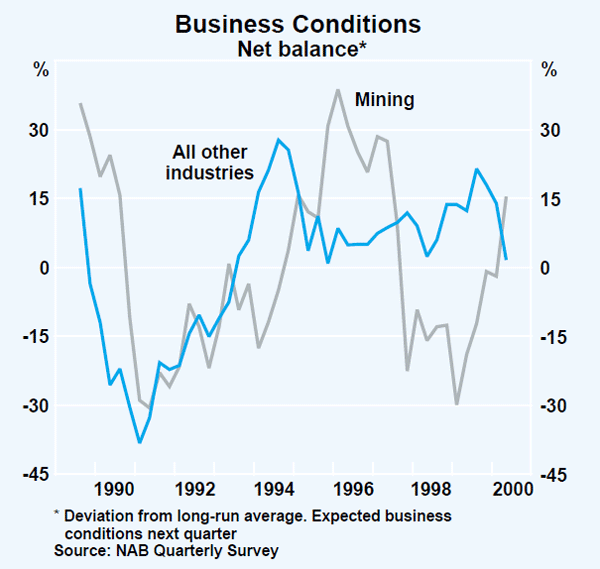
While data for retail sales reported a decline in the March quarter, there was also a large run-down in business inventories at this time as measured by the ABS, particularly in the retail sector. This juxtaposition of events is surprising, given the strong growth in imports in the quarter and the business surveys which indicated that inventories increased in the March quarter.
The decline in business sentiment did not hinder strong growth in business investment in the March quarter. This rise in investment largely reflected a solid rise in spending on machinery and equipment (Graph 20). While the quarterly investment outcomes recorded in the national accounts have been volatile, throughout 1999/2000, successive surveys of capital expenditure by the ABS indicated higher expected investment spending for the year as a whole. Strength in recent quarters has been evident in the communications, finance and property, and business services sectors. Investment in the manufacturing, retail, wholesale, and transport and storage sectors has been either steady or falling.

It is difficult to discern a clear picture of investment intentions in 2000/01, because it is unclear the extent to which businesses have taken account of the lower prices for many investment goods resulting from the replacement of wholesale taxes with the GST on 1 July. (Firms were asked by the ABS to report their investment intentions net of the GST.) According to the ABS Capital Expenditure Survey, firms expect to increase spending on machinery and equipment investment in nominal terms by only 1½ per cent in 2000/01, once average realisation ratios are applied. Assuming that businesses did indeed take account of the lower prices on investment goods after 1 July, this implies that there is likely to be stronger real growth in investment in plant and equipment in 2000/01. As a share of GDP, investment is around average levels, suggesting there is scope for it to grow as the economy continues to expand.
The non-residential building component of buildings and structures investment also rose strongly in the March quarter, although this was not enough to offset a large fall in engineering construction. Expenditure on engineering construction has been particularly weak since the beginning of 1999 and is nearly one-quarter lower than the level a year earlier. The immediate outlook for non-residential building work has improved slightly, with building approvals picking up from the trough reached late last year. Increased pressure on office rentals, particularly in Sydney and Melbourne, points to some scope for future growth in new office projects. According to the Access Property Monitor, growth in building work is projected to occur in the retail and wholesale sectors. By contrast, the value of building projects in the hospitality sector (hotels and resorts) is expected to fall.
The estimates of intangible investment (which comprises computer software, minerals exploration and artistic originals) and livestock investment continued to grow strongly in the March quarter, to be just over 20 per cent higher than a year earlier. Some of the strength in the first half of 2000 probably relates to businesses purchasing software to assist with the new tax arrangements and the associated change in business reporting requirements. Some purchases may also have been brought forward as software prices were expected to increase from 1 July. Mineral exploration expenditure has continued to decline. Expenditure in the March quarter was around half the peak level of expenditure recorded in 1997, with a reduction in gold exploration accounting for most of the fall.
The labour market
Following a pick-up in the second half of 1999, employment growth remained at an above-average rate in the first half of 2000. Employment increased by 285,000, or 3¼ per cent, over the year to the June quarter, substantially faster than the rate of growth prevailing for most of the previous four years; almost three-quarters of the increase was in full-time employment. The recent strength in employment growth contributed to a further decline in the unemployment rate to 6¾ per cent in the June quarter, compared with almost 7½ per cent a year ago (Graph 21). The participation rate continued to rise in the first half of the year, reflecting the strengthening labour market and buoyant economic activity generally, reaching 63¾ per cent in the June quarter. The female participation rate has risen more sharply than the male equivalent over the past year.
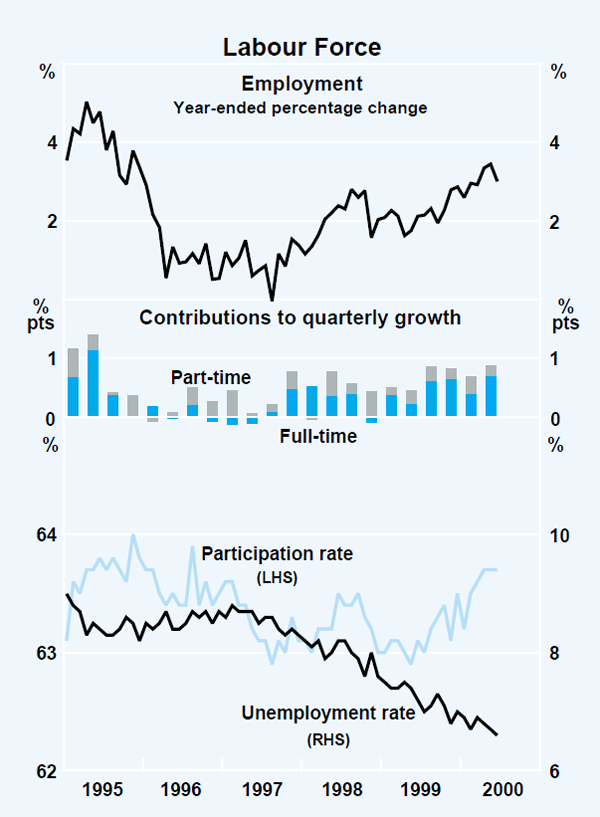
Strong employment growth over the past year has occurred in most states and has contributed to falls in unemployment rates in every state (Table 7). The recent strength in national employment growth has been underpinned by increases in employment growth in NSW and Victoria, partly driven by the rapid growth in residential housing investment in those states. Employment growth over the year to the June quarter was 3.3 per cent in both state capitals and non-metropolitan areas. In the June quarter, the unemployment rate in the capital cities was 6.1 per cent, almost a percentage point lower than a year earlier. The unemployment rate in non-metropolitan areas has fallen more modestly, to 8.1 per cent, associated with a larger rise in labour force participation in non-metropolitan areas.
| NSW | VIC | QLD | SA | WA | TAS | Australia | |
|---|---|---|---|---|---|---|---|
| Employment growth | |||||||
| – Year to June quarter 2000 | 4.3 | 3.4 | 2.3 | 2.2 | 3.0 | 1.5 | 3.3 |
| Unemployment rate(a) | |||||||
| – June quarter 1999 | 6.6 | 7.7 | 8.1 | 8.5 | 6.9 | 10.0 | 7.4 |
| – June quarter 2000 | 5.8 | 6.7 | 7.8 | 8.3 | 6.4 | 9.5 | 6.7 |
| (a) Seasonally adjusted by the RBA | |||||||
The pick-up in employment growth and relatively stable output growth over the past year has resulted in a fall in measured labour productivity growth. In terms of output per hour worked, year-ended productivity growth has eased to about 1¾ per cent, down from the average of 3¼ per cent prevailing in the previous three years. Abstracting from short-term fluctuations, productivity growth remains relatively robust, with gains in the current expansion spread across most industries.
While a high level of job vacancies continues to indicate strong employment growth in the near term, information on employment intentions from the major business surveys has been weaker recently (Graph 22). The ABS job vacancies series, which surveys employers, recorded a new high in May, with the recent rise concentrated in the public sector and in Victoria. The newspaper-based job advertisements series published by both the ANZ Bank and the Department of Employment, Workplace Relations and Small Business have softened recently, with both series falling over the past three months, though they remain at high levels. Employment intentions reported in the NAB business survey and the ACCI-Westpac survey of manufacturers have fallen below their peaks recorded in mid 1999, with the NAB business survey recording its lowest level of employment intentions in two years. Forward-looking indicators of labour demand in the construction sector suggest a significant decline from current levels, in line with the expected decline in construction activity noted above. The major business surveys suggest that the difficulty firms face in finding suitable labour has eased slightly in the past six months but remains at relatively high levels.
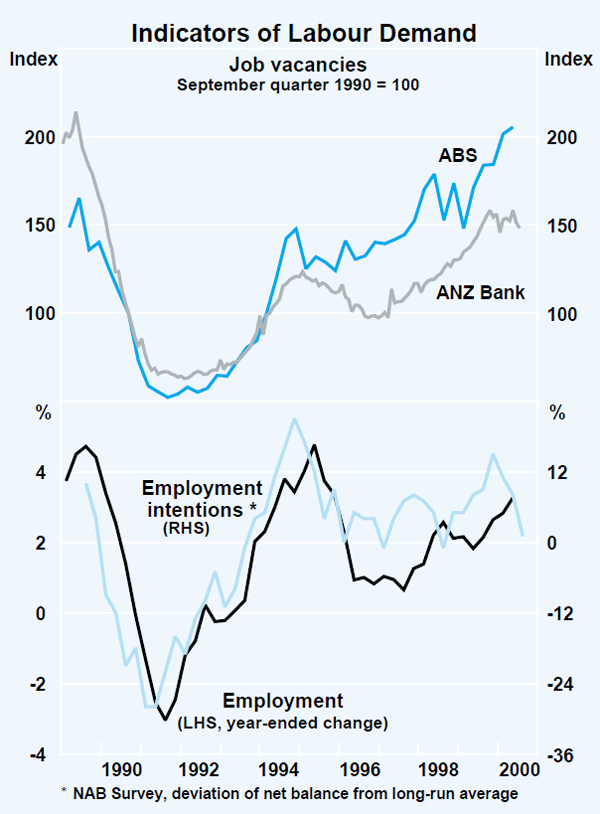
Balance of Payments
Export revenues have continued to grow rapidly due to stronger world demand, the depreciation of the Australian dollar and firmer commodity prices (Graph 23). These gains in the value of exports have been to most major destinations, with the growth of exports to East Asia being particularly pronounced (Graph 24). The strong increase in export receipts, however, has been matched by solid growth in the value of imports. This reflects the continuing strength in domestic demand and, in the most recent period, stronger import prices. As a result, the trade deficit has remained at around 2 per cent of GDP for the last three quarters, although it has declined from the peak reached in the middle of 1999.

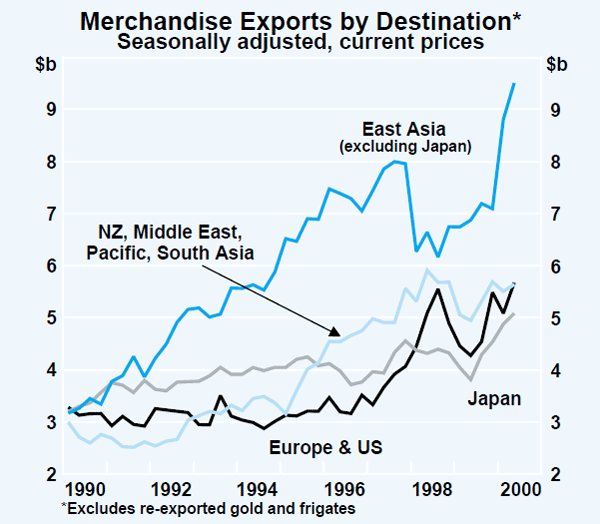
Most major categories of export earnings have increased strongly over the past year (Graph 25). The value of resource exports (excluding re-exported gold) increased by over 40 per cent over the past year, with this strength reflecting a combination of stronger volumes and prices. Exports of oil, gas and petroleum products accounted for a substantial portion of the rise, due to sharp increases in the price of crude oil and significant expansions in production capacity. Other major resource exports, like metal ores and processed metals, also benefited from capacity expansions, higher prices and the continued improvement in trading partner growth, particularly in East Asia. Steaming coal exports, after a period of weakness through late 1998 and 1999, have recovered in the first half of 2000, particularly to South Korea and Taiwan.

The growth in rural exports in the first half of the year resulted from strength in the export of wool products and other rural goods (particularly canola). These volume gains were driven by record levels of farm production, and were supported by stronger prices, particularly for meat and wool products.
According to the Australian Bureau of Agricultural and Resource Economics (ABARE), the total area planted to winter crops is forecast to be a record 19.2 million hectares in 2000/01, following good planting rains across most grain-growing areas in the eastern states. Total meat production is forecast to fall slightly in 2000/01 as cattle herd rebuilding continues, though live cattle exports are expected to increase, reflecting a further improvement in Asian demand. Wool production is expected to fall slightly. Overall, ABARE expects the volume of farm production in 2000/01 to at least match the record levels achieved in 1999/00, and this will support rural export volumes over the year ahead.
Manufactured export earnings again increased strongly in the June quarter, and were 19 per cent higher than in the corresponding period last year. As has been the case since the middle of 1999, much of the growth has been recorded in exports of transport equipment. Growth in manufactured exports to the European Union, the United States, the Middle East, and recoveries in demand from non-Japan Asia, have underpinned this strength.
Service exports increased moderately in the first half of 2000. After a slight fall in the March quarter, tourism revenues rebounded strongly in the June quarter as arrivals from Japan, the United Kingdom and New Zealand all increased solidly. Export earnings related to sponsorships, royalties and tourism are expected to rise substantially in the September quarter due to the staging of the Olympics in Sydney. Travel exports may also be boosted in coming periods if the exchange rate remains around current levels.
The value of imports of goods and services rose again in the June quarter, to be around 20 per cent higher than a year earlier. However, the strength in the June quarter, in contrast to previous quarters, is largely due to higher import prices, rather than continued growth in import volumes. Indeed, in volume terms, headline imports of goods and services appear to have remained flat in the June quarter, following very strong growth in the March quarter. Over the past year, the volume of imports in both headline and underlying terms has risen by a little over 10 per cent, reflecting the continuing strength in domestic demand.
Capital imports were weaker in the June quarter, although this softening in demand followed exceptional strength in the March quarter. Imports of major capital equipment, such as machinery, computers and telecommunications equipment, remain at very high levels. Consumption import volumes remained firm, with growth in excess of 12 per cent over the past twelve months. Imports of motor vehicles increased noticeably in the June quarter as retailers and wholesalers stockpiled cars in anticipation of stronger demand in the second half of the year. While the growth of underlying intermediate imports has moderated from the exceptionally strong growth observed in the latter half of 1999, it continues to grow in line with the pace of growth of the domestic economy. Service import volumes have increased by 9 per cent over the past year.
Net foreign liabilities rose by 1 per cent in the March quarter to $383 billion, or 61 per cent of GDP. Net foreign debt rose to 41 per cent of GDP, on account of both increased foreign borrowings and valuation effects flowing from the depreciation in the A$ in the quarter. These valuation effects, however, also resulted in a decline in net foreign equity liabilities in the quarter. The net income deficit widened to $4.7 billion in the March quarter, with increased income inflows due to higher returns on equity investments abroad partially offsetting growth in outflows. The ratio of net income payments to exports remains around 16 per cent.
Commodity prices
Commodity prices generally moved higher again during the June quarter, reflecting stronger world demand and a recovery in rural prices. Base metal prices, which rose strongly in the second half of 1999, have fallen a little over the first half of this year.
The price of oil rose by around US$5 per barrel over the June quarter, with the price of West Texas Intermediate crude oil trading above US$30 per barrel for much of June (Graph 26). The rise reflected a growing realisation that the first increase in OPEC production quotas, which were negotiated in March, might not match increases in world demand. In late June, OPEC members decided to increase their crude oil output quotas further from 1 July. However, in contrast to the reaction following the March output increase, the oil price did not fall sharply following this announcement, as the market judged the increase was again likely to be insufficient to exceed projected increases in global demand. Subsequent statements have seen some OPEC member countries canvassing the possibility of further quota increases, placing downward pressure on prices since early July. However, such suggestions have elicited a mixed response from other member countries, and, to date, no official increase in OPEC production targets has been agreed.
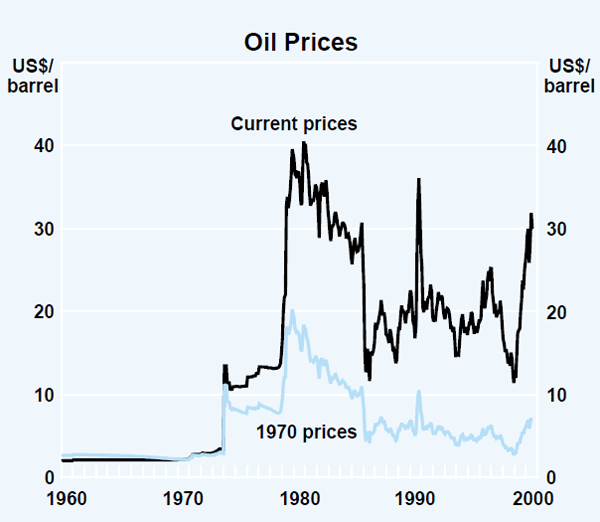
In SDR terms, the Bank's index of commodity prices increased again in the June quarter, to be about 7 per cent higher than a year earlier (Graph 27). Continued strong gains in rural commodity prices underpinned the strength in the June quarter, while the base metals index fell for the first time since early 1999.
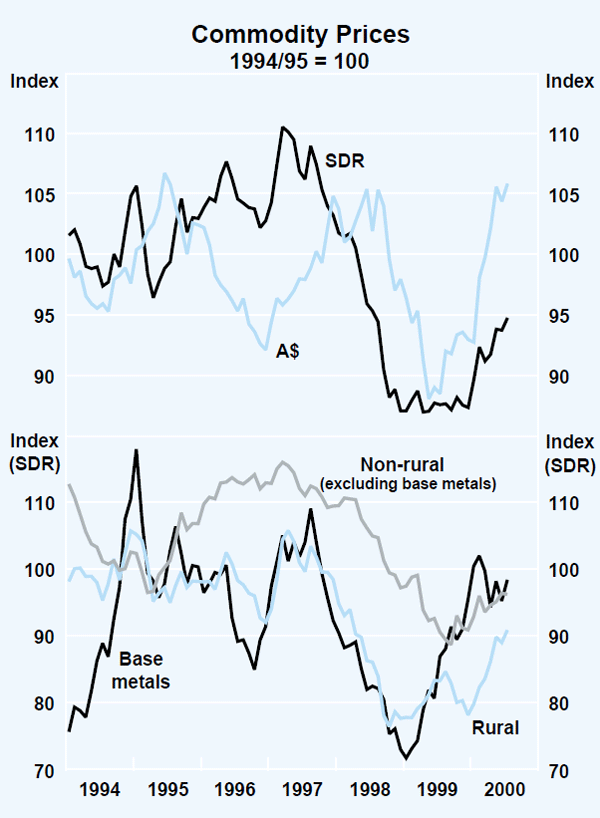
The price of every component of the rural index rose in the quarter, in both domestic and foreign currency terms, with sugar, cotton, and wool prices exhibiting particular strength. The sugar price increased by more than one-third on expectations of lower output from Brazil, the world's largest producer, and buying interest from Asia (particularly the Philippines). Cotton prices also experienced a second consecutive quarter of very strong gains, on forecasts that world demand would substantially exceed supply next year. In foreign currency terms, wool prices gained over 7 per cent in the quarter, due to rising demand for the finer wools. Wheat prices increased by almost 5 per cent in the quarter, staging strong gains early in the period on fears that dry weather in several large producer countries (in particular the US) would result in lower world supply. An unexpectedly large purchase from a major importer (Egypt) also pushed prices higher.
The non-rural index of commodity prices (excluding base metals) remained unchanged in the quarter. Although the 4–5 per cent falls in negotiated contract prices for steaming and coking coal came into effect on 1 April, there was a recovery in the spot market for these commodities in the quarter. Iron ore contract prices rose by between 4 and 6 per cent in the quarter. Despite some gains towards the end of the June quarter, the price of gold fell marginally due to lacklustre demand.
Base metal prices fell by close to 5 per cent in the June quarter, but remain around 20 per cent higher over the year. Aluminium, lead and copper prices all fell, dragged down by concerns that the US economy is slowing. Nickel prices increased slightly in the quarter, but were volatile; after reaching a peak in mid May, the resolution of labour disputes at major Canadian producers saw prices fall sharply through late May and June before stabilising in early July.
Domestic Financial Markets
Australian dollar
The behaviour of the Australian dollar so far in 2000 can be divided into a number of phases. The first few months of the year, through to the second half of April, were a period of unilateral Australian dollar weakness (Graph 28). The trade-weighted index fell by a similar amount to the rate against the US dollar.
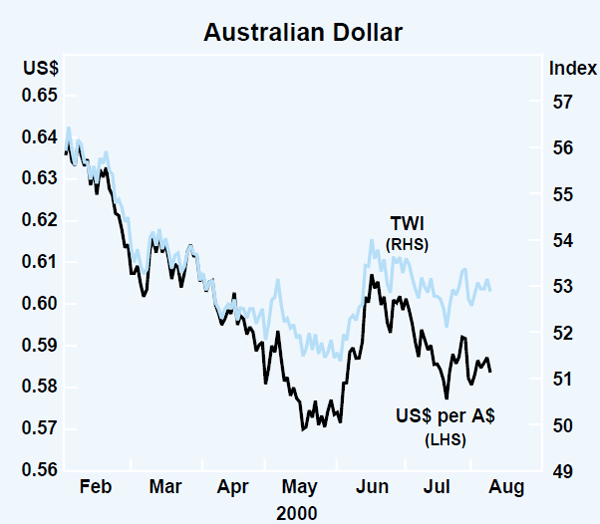
From late April and into May, the currency continued to fall against the US dollar, but this was mainly a reflection of US dollar strength. The Australian dollar was steadier in trade-weighted terms and, indeed, it rose against some currencies, including the euro, during this period.
The initial recovery in the Australian dollar in early June continued to be mainly a mirror image of US dollar movements (i.e. the reversal of the US dollar strength). As such it was less pronounced in trade-weighted terms. Following the release of National Accounts data, however, which were a good deal stronger than expected and prompted many analysts to conclude that their earlier assessments of a slowing in the economy had been overstated, the exchange rate moved higher against all currencies.
More recently, the currency has fallen somewhat again. For a time, this was associated with the weakness in some Asian currencies, both because markets see Australia's prospects as being closely tied to those of Asia and because some investors sold into the Australian market as a proxy for the less liquid Asian currency markets. Subsequently, it became mainly a reflection of re-emerging US dollar strength. As such, the fall in the Australian dollar's rate against the latter currency again became more pronounced than the fall in the trade-weighted index.
The market responded to the August monetary announcement with a small rise in the exchange rate. Nonetheless, it remains at a relatively low level. At around US58 cents, it is 10 per cent below its average level for 1999. The trade-weighted index is about 7 per cent below its 1999 average.
The Bank has not undertaken any operations in the foreign exchange market in recent months to influence the currency.
Market interest rates
After the four increases in official interest rates between November 1999 and May 2000, short-term market interest rates fell for a time as markets became more comfortable with the outlook for inflation. This was similar to the experience in many other countries. More recently, however, Australian short-term yields moved up again in response to the run of economic news, particularly that on inflation (Graph 29). A significant probability of an August tightening had been priced into market yields in the days before its announcement, and it was followed by only a modest further rise in yields. As of early August, the yield on 90-day bank bills was 6.4 per cent.

As has been a feature of recent years, yields on long-term government bonds in Australia have continued to move broadly in line with those in the United States (Graph 30). Bond yields here and in the US peaked in early 2000 and have since fallen. In Australia, the peak in the 10-year yield was 7.25 per cent, and the current level is 6.1 per cent. This fall has been larger than the fall in the United States so that the spread between 10-year yields in the two countries has narrowed from about 60 basis points to about 20 basis points.
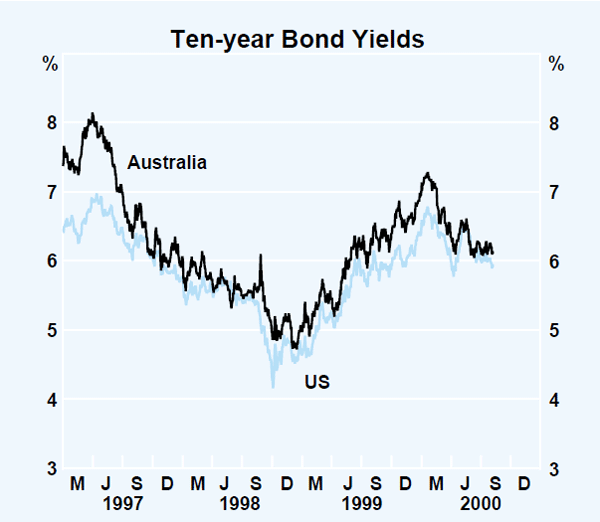
For a period in early May, bond yields in Australia had moved below those in the United States, i.e. the differential had become negative. The only other time this had happened was in mid 1998, when there were concerns about the outlook for the Australian economy due to the expected impact of the Asian crisis. In the more recent episode, it largely reflected expectations that the tightening cycle in the United States would be noticeably more pronounced than in Australia.
As in a number of other countries, bond issuance in Australia in recent years has shifted away from the public sector toward the private sector. With $74 billion of non-government bonds outstanding, this sector is now larger than the market for Commonwealth Government securities (Graph 31).
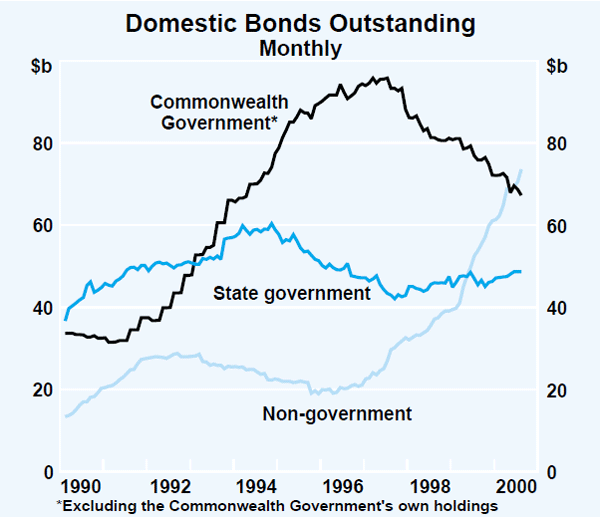
This points to the need to look at movements in interest rates beyond those on government securities. The recent fall in corporate yields has been a little less than that in government yields. For ‘A’ rated corporates, the spread over government bonds of comparable maturity is currently about 100 basis points, which is noticeably wider than a couple of years ago (Graph 32).
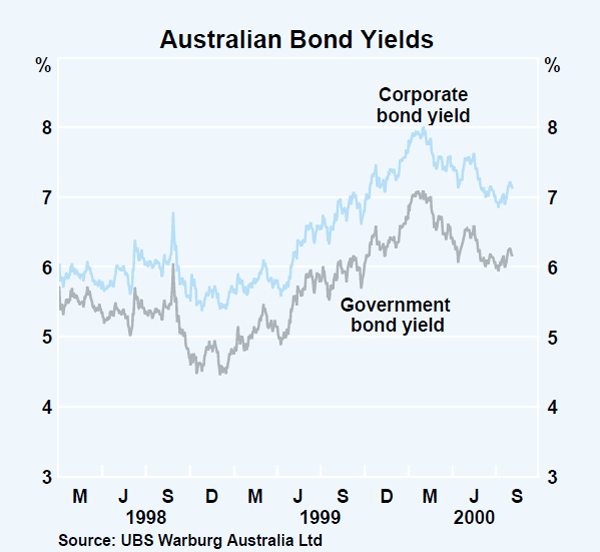
The repricing of credit risk has been evident in several countries, although these shifts are more prominent in the United States and United Kingdom than in other countries, as can be seen in the spread between yields on government bonds and yields in swap markets (Graph 33). The 10-year swap spread in the United States, for example, has increased in 2000 by about 50 basis points, to a level higher than at the time of disruptions in markets during the LTCM crisis in 1998.
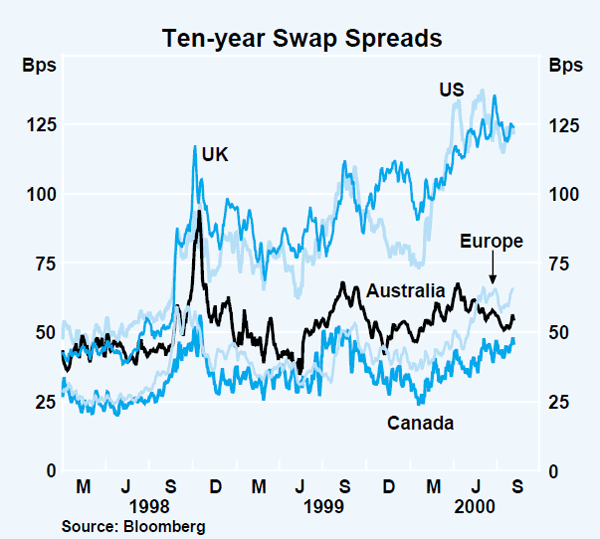
Some commentators have attributed the widening in spreads to the reduced supply of government paper, but this does not appear to be the entire story. The reduction in public sector debt has been larger in Australia than in the United States (and elsewhere) and the short-term outlook is for this to continue. Yet spreads in Australia have not increased as much. The diminution of supply of government bonds therefore seems, at best, to be a partial explanation of rising credit spreads (Table 8).
| Net debt issuance | Net equity raising |
Change in swap spread |
||
|---|---|---|---|---|
| Public(a) | Private | |||
| Cumulative change, per cent of GDP | Basis points | |||
| United States | −2 | 27 | −6 | 70 |
| Euro area | 6 | 5 | na | 30 |
| United Kingdom | 1 | 16 | 3 | 85 |
| Canada | 1 | 6 | 6 | 15 |
| Australia | −8 | 13 | 13(b) | 15 |
|
(a) Central government (b) Excluding privatisations |
||||
Other factors may have been a degree of illiquidity in the swap market in the face of large increases in private sector bond issuance and rising interest rates. Rising interest rates are likely to result in investors projecting ahead to slower economic growth and the possibility of higher default rates. These concerns might recently have been exacerbated by changes in the pattern of corporate financing: in countries in which the swap spread has increased the most – the US and UK – growth in private sector bond issuance has been relatively large, while net equity issuance has been low (or even negative as in the United States). This switch from raising funds in equity markets to bond markets would, other things equal, also tend to raise concerns about credit quality, as corporate leverage would tend to rise. By contrast, while private-sector bond issuance has been high in Australia and, to a lesser extent, Canada, new equity has been equally high.
Intermediaries' interest rates
Banks raised interest rates on most categories of variable-rate loans by a similar amount to the rises in the cash rate between November 1999 and May 2000 (Table 9). Some business overdraft rates had risen by slightly more than this. Those banks which so far have announced changes to interest rates following the tightening in early August have also matched the rise in the cash rate. In addition, some banks have announced increases in interest rates on selected lending products of between 1 and 15 basis points to recover the added cost of inputs which attract the GST. (Financial services are ‘input-taxed’, meaning that financial service providers cannot claim a tax credit for these costs.)
| Change between end October 1999 and July 2000 |
Level as at July 2000 |
Cyclical low in 1993/94 |
|
|---|---|---|---|
| Household | |||
| Housing | |||
| Standard variable | 1.25 | 7.80(a) | 8.75 |
| Basic | 1.30 | 7.25 | na |
| Personal | |||
| Residential-secured overdraft | 1.30 | 7.95 | 9.75 |
| Credit card(b) | 1.15 | 16.45 | 14.35 |
| Memo Item: | |||
| Mortgage managers' rate | 1.35 | 7.55 | 7.70 |
| Business | |||
| Small business | |||
| Residential-secured | |||
| – Overdraft | 1.40 | 8.35 | na |
| – Term | 1.30 | 7.95 | na |
| Other(c) | |||
| – Overdraft | 1.45 | 8.90 | 9.30 |
| – Term | 1.35 | 8.40 | na |
| Large business | |||
| – Overdraft | 1.40 | 9.35 | 9.00 |
| – Term | 1.35 | 9.25 | na |
| Cash Rate | 1.25 | 6.00 | 4.75 |
|
(a) By 9 August, the major banks had each announced an increase in mortgage rates
of 0.25 of a percentage point following the tightening of 2 August. The
average level of this rate was 8.05 per cent. (b) With interest-free period. (c) Both secured by other assets and unsecured. |
|||
The level of intermediaries' interest rates for households and small businesses remains historically low – in particular, notwithstanding the fact that the cash rate exceeds by 1.5 percentage points its level at the previous cyclical trough in 1993/94, rates paid by borrowers, especially for housing, typically remain below their level at that time.
Mortgage managers have, on average, raised their housing interest rates by more than banks because they fund their lending in wholesale markets, whereas banks also draw on a low-cost supply of retail deposits: since money market interest rates over the past year have tended to trade significantly above the cash rate, mortgage managers' margins have been squeezed.
The pattern of increases in credit card rates has varied from bank to bank. While the average increase by the major banks since end October is a little smaller than the rise in the cash rate, banks did not lower credit card rates by as much as the cut in the cash rate during the previous easing phase. On the whole, margins on credit card lending have tended to widen since the mid 1990s.
The flagship small business rate – on residentially secured term loans – has been increased in line with the cash rate. Rises in other indicator rates on loans to small businesses have, on average, tended to be larger than this as some banks have raised some rates independent of monetary policy moves (including by some banks to recoup the costs of the GST). Measured across all loan products, and taking into account changes in customer risk margins, however, it seems that interest rates paid on average by small businesses have increased by a little less than the rise in interest rates directly due to the tightening of monetary policy. This is because small businesses lending has been migrating to low-interest rate loan products, such as residentially secured loans.
Interest rates on new fixed-rate loans have fallen over recent months, reflecting falls in yields in capital markets in which these loans are funded (Graph 34). Banks' 3-year fixed housing lending rates have fallen by an average of 35 basis points, from their peak earlier in the year, to 7.60 per cent. The corresponding indicator rate for small businesses has fallen by 55 basis points from its peak, to 8.20 per cent. Fixed-rate loans for housing have fallen by less than those for small businesses since they had also risen by less during the phase of rising yields in capital markets in 1999.

The increases in banks' retail deposit rates since last year have, in most cases, been smaller than the rise in the cash rate (and lending rates), especially for transaction accounts and accounts with small balances. (Some deposit rates were also reduced to cover rises in costs of banks' inputs associated with the introduction of the GST.)
Financial aggregates
Credit growth remains strong and has picked up noticeably in recent months, driven by an acceleration in both business and housing credit (Table 10). Credit outstanding increased at an annual rate of more than 15 per cent over the first half of this year, and by just over 13 per cent over the year to June. Growth in housing credit has been consistently strong for an extended period, and has picked up further in the first half of this year, with much of the strength concentrated in borrowing to purchase investment properties. Business credit growth, in contrast, was quite weak around the middle of 1999, but in recent months has recovered to reach an annualised rate of around 13 per cent over the first half of 2000. While growth in personal credit has slowed a little, it remains robust. Within personal credit, revolving finance such as credit cards and overdrafts have continued to be stronger than traditional fixed-term loans.
|
Year to June 2000 |
Six months to: | ||
|---|---|---|---|
| December 1999 | June 2000 | ||
| Total credit | 13.1 | 10.8 | 15.4 |
| – Personal | 17.5 | 20.1 | 15.0 |
| – Housing | 17.5 | 16.2 | 18.7 |
| – Business | 8.7 | 4.7 | 12.8 |
| Currency | 7.1 | 8.1 | 6.1 |
| M3 | 7.5 | 4.9 | 10.1 |
| Broad money | 7.3 | 3.7 | 11.1 |
Margin lending by banks and brokers grew by 3.6 per cent in the June quarter, somewhat slower than the increase of around 10 per cent in each of the previous three quarters. The earlier large rises reflected the second tranche of the privatisation of Telstra and strong activity in the share market by retail investors. With the market being more subdued of late, demand for margin loans has increased less quickly. Margin lending now stands at $6.5 billion, and accounts for approximately 9 per cent of non-housing personal credit outstanding.
Growth in the deposit aggregates has picked up from a slower period in the latter half of 1999. Both M3 and broad money registered robust growth in the three months to June, and annualised growth over the first half of 2000 was over 10 per cent. This compares with annual growth rates of around 4 per cent over the six months to December 1999. The pick-up in current (cheque-linked) deposits has been particularly marked. In contrast, abstracting from the increased circulation of cash around the end of last year, annual growth in currency has been relatively stable at around 7–8 per cent for a number of years.
The financial aggregates are likely to become somewhat more volatile in coming months, due to a change to reporting arrangements that will remove some of the smoothing effect generated by averaging data within individual months. Analysis of trends in credit growth will therefore need to take account of a greater degree of noise in the series in the future.
Managed funds
Growth in funds under management slowed to 3 per cent in the March quarter, from 5.3 per cent in the December quarter, and was 15 per cent over the year to the March quarter. The increase in the value of assets during the latest quarter was mainly driven by strong growth in the value of equities and units in trusts, and overseas assets (Table 11). With domestic share prices relatively flat over the March quarter, the increase in equities and units in trusts suggests net inflows to this asset class. Similarly, the growth in overseas assets in the quarter probably reflected valuation effects flowing from the depreciation of the exchange rate in the quarter or net inflows to this asset class; the mixed performance of overseas equity markets during this period implies that valuation effects flowing from increases in equity prices would have been small. Institutions with high exposure to overseas assets, particularly superannuation funds and public unit trusts, recorded the largest asset gains in the quarter.
| Percentage change | Per cent of total | ||
|---|---|---|---|
| March 2000 | Year to March 2000 | ||
| Cash & deposits | −0.9 | 9.4 | 7 |
| Loans & placements | 5.1 | 23.0 | 5 |
| Short-term securities | −0.8 | 0.8 | 10 |
| Long-term securities | 0.1 | 0.0 | 13 |
| Equities & units in trusts | 2.8 | 15.1 | 30 |
| Land & buildings | 4.8 | 16.5 | 11 |
| Assets overseas | 6.9 | 36.4 | 21 |
| Other assets | 4.2 | 14.0 | 3 |
| Total | 3.0 | 15.0 | 100 |
Share market
Share prices in Australia softened early in the June quarter, in line with US developments. Since then, however, the Australian market has done better than its US counterpart and prices attained a record high in July. The ASX 200 index is about 12 per cent above its low point in the June quarter, and its level a year ago.
The industrial and resource sectors have both shown relatively small increases over the past year; stocks of financial companies are up by 15 per cent (Graph 35).
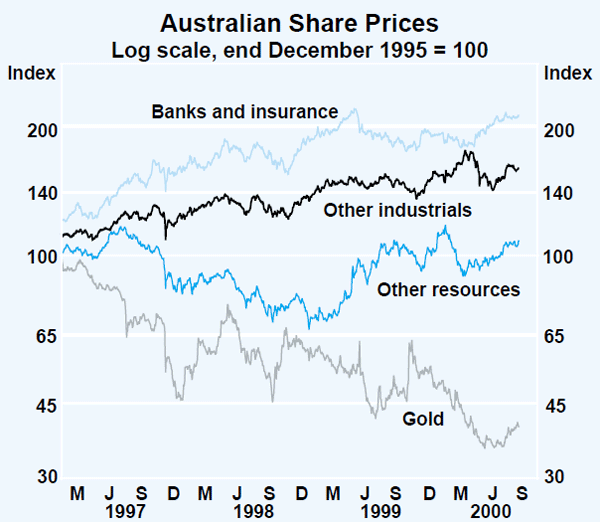
Inflation Trends and Prospects
Recent developments in inflation
Consumer prices
Measures of consumer price inflation continue to increase. The Consumer Price Index (CPI) increased by 0.8 per cent in the June quarter 2000 and by 3.2 per cent over the year (Graph 36). Measures of underlying inflation, which are less sensitive to movements in the volatile components of the CPI, indicate that inflation has gradually increased to around 2½ per cent from its recent trough of around 1½ per cent (Graph 37). While some of the rise in inflation over the past year or so reflects increases in the price of oil and tax-related increases in the cost of insurance, house purchase and cigarettes and tobacco, the pick-up in inflation has been quite broadly based (Table 12).
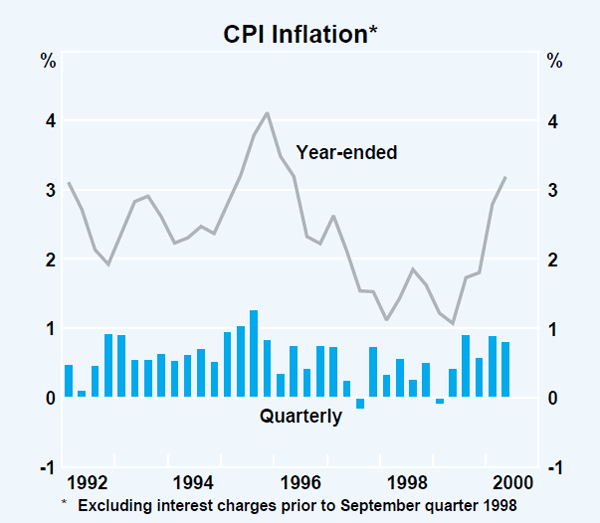
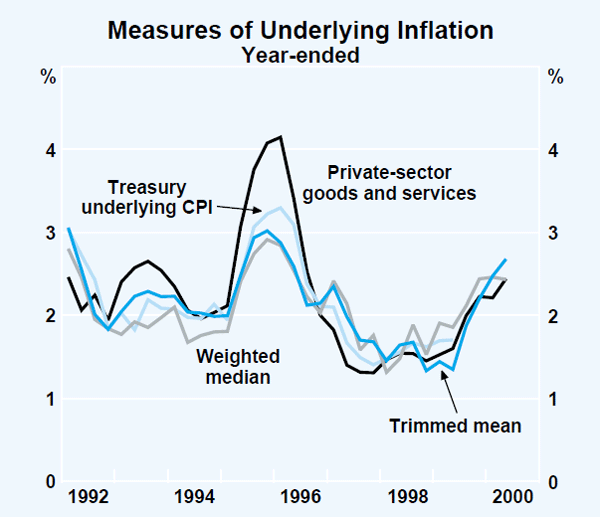
| Quarterly | Year ended | ||||
|---|---|---|---|---|---|
| March quarter 2000 |
June quarter 2000 |
March quarter 2000 |
June quarter 2000 |
||
| Headline CPI | 0.9 | 0.8 | 2.8 | 3.2 | |
| – Tradeable component | 0.5 | 1.0 | 1.8 | 2.0 | |
| – Non-tradeable component | 1.3 | 0.7 | 3.8 | 4.2 | |
| CPI excluding volatile items | 0.7 | 0.6 | 2.2 | 2.6 | |
| Private-sector goods and services | 0.5 | 0.6 | 2.2 | 2.4 | |
| Weighted median(a) | 0.7 | 0.4 | 2.5 | 2.4 | |
| Trimmed mean(a) | 0.7 | 0.6 | 2.5 | 2.7 | |
| (a) For details on the calculation of these measures, see ‘Measuring ‘Underlying’ Inflation’, RBA Bulletin, August 1994. | |||||
Retail petrol prices increased by 3.2 per cent in the June quarter, reflecting a combination of higher world prices of oil over the past six months as well as the influence of a lower exchange rate. Together, these two factors led to an increase in the Australian dollar price of crude oil of around 7 per cent in the June quarter. Over the past year, retail petrol prices have risen by 22 per cent, contributing 0.9 percentage points to the increase in the CPI over that time. In recent weeks, the price of crude oil has fluctuated around a level close to the June quarter average. Assuming that the exchange rate remains around its current level, this would imply little further change in petrol prices at the pump in the September quarter (Graph 38).
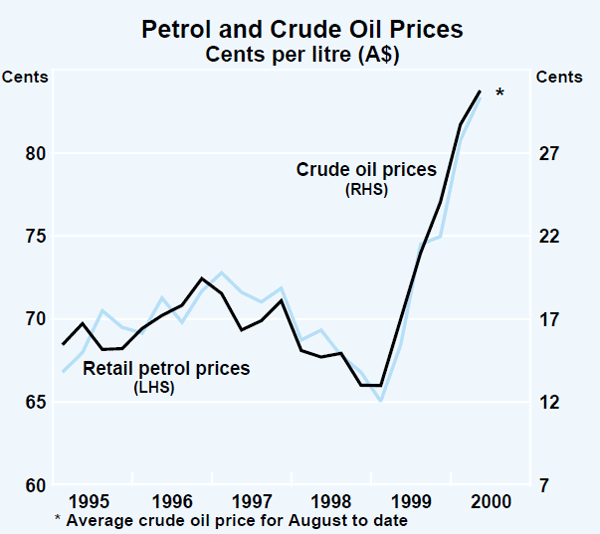
The large rise in the house purchase component of the CPI over the past year has contributed to the increase in the CPI and to most measures of underlying inflation. The cost of house purchase increased by 0.4 per cent in the June quarter and by 7.5 per cent over the year to the June quarter. The increase over the past year has reflected the strength of housing activity and the emergence of capacity constraints in the industry, as discussed above in the chapter on ‘Domestic Economic Activity’. The strength in the housing industry has been supported by underlying demand factors, notably the growth of incomes and the relatively low cost of housing credit, but it has also partly reflected the desire to complete work before the introduction of the GST.
A range of other prices are likely to have been affected by the changes to the tax system before the introduction of the GST on 1 July, though in ways that are difficult to measure precisely. The payment of GST on insurance premiums has boosted those components of CPI inflation over the past year; the method of measurement based on premiums net of claims means that the recorded price of insurance in the CPI has increased by more than the GST rate. Working in the other direction, the reduction in the top wholesale sales tax rate on some items last year, such as televisions and VCRs, had a small offsetting effect. Motor vehicle prices also appear to have been lower than otherwise, rising by only ½ per cent over the past six months despite the exchange rate depreciation, reflecting discounting ahead of the introduction of the GST in an attempt to smooth sales.
Private-sector services prices have increased at a consistently faster pace than private-sector goods prices for most of the past six years (Graph 39). While this pattern has continued over the past year, much of the discrepancy in recent quarters is accounted for by the contribution of GST-related increases in the cost of insurance to private-sector services prices. Excluding insurance, private-sector services prices rose by 0.5 per cent in the June quarter and by 2.5 per cent over the year.
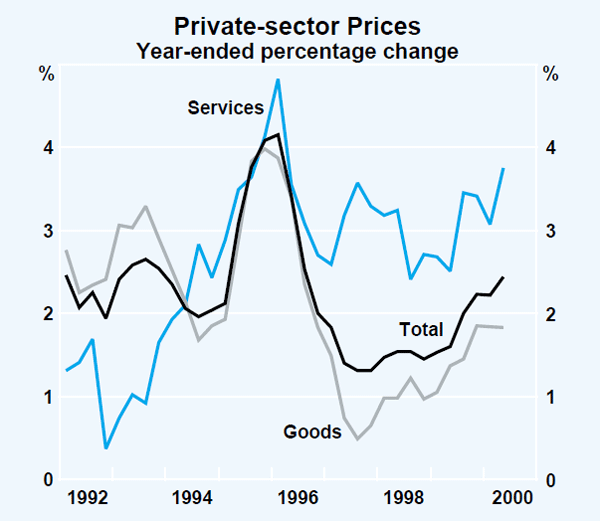
Over the past year, the price of tradeables continued to grow more slowly than that of non-tradeables. The 1 per cent increase in the price of tradeables in the June quarter reflected a large increase in petrol prices, but also higher prices for fresh vegetables and overseas travel and accommodation, with the latter increase, in part, due to seasonal factors. Abstracting from the effect of oil, tradeables prices increased by 0.8 per cent in the June quarter and by 0.2 per cent over the past year. However, the recent weakness of the exchange rate is likely to result in larger increases in the price of tradeables over the coming year (see below). The price of non-tradeables rose by a little over 4 per cent over the past year; this component comprises mainly services and includes the cost of house purchase.
The exchange rate and inflation
In import-weighted terms, the Australian dollar has depreciated by around 5½ per cent since the beginning of the year. The lower exchange rate contributed to the sharp increase in the wholesale price of manufactured goods in the June quarter, for example, in meat products and petrol. Some pass-through of these wholesale price increases to retail prices is apparent in the June quarter. However, the recent rise in manufacturing wholesale prices, excluding petrol, is likely to be seen more fully in retail goods prices in coming quarters.
The overall effect of the currency depreciation on inflation is subject to considerable uncertainty. The depreciation of the Australian dollar during the Asian crisis had little discernible effect on final consumer prices over the subsequent couple of years. However, a number of factors suggest that the depreciation of the currency over the course of this year is more likely to be passed through to final consumer prices. Conditions in the economy are tighter now than in the aftermath of the Asian crisis, the deflationary impulse from Asian producers is no longer present and world commodity prices are rising.
Recent movements in the exchange rate have also been reflected in indexes of trade prices; the export price index rose by more than 16 per cent over the past year, with higher prices for base metals, chemicals, and petroleum aided by higher world prices and increased demand. Prices of imported consumption goods at the docks increased by almost 4 per cent in the June quarter, after a very modest rise in the March quarter, and have now regained their level of nearly two years ago.
Producer prices
A wide range of producer prices increased sharply in the June quarter (Table 13). Although some specific factors have contributed considerably to these increases, most notably the rise in oil prices and the depreciation of the exchange rate, the pick-up in producer price inflation has been broadly based.
| June quarter |
Year to June quarter |
|
|---|---|---|
| Producer prices by stage of production | ||
| Preliminary commodities | 3.3 | 8.3 |
| Intermediate commodities | 2.5 | 6.7 |
| Final commodities | 1.8 | 5.0 |
| Manufacturing | ||
| Input prices | 4.8 | 16.4 |
| – Domestic | 4.5 | 19.0 |
| – Imported | 5.5 | 13.0 |
| Final prices | 1.9 | 7.3 |
| – Excluding petroleum | 1.4 | 4.7 |
| Construction | ||
| Materials used in house building | 1.4 | 5.3 |
| Materials used in other building | 0.9 | 1.7 |
| Services | ||
| Transport and storage | 0.8 | 1.6 |
| Property and business services | 2.0 | 6.3 |
| Merchandise trade | ||
| Export prices | 6.2 | 16.7 |
| Import prices | 5.5 | 9.3 |
Both domestic and imported manufacturing input prices increased strongly in the June quarter, largely reflecting the continued rise in the world price of oil and the 10 per cent depreciation of the exchange rate over the past year. Excluding oil, the domestic component increased by around 1 per cent in the June quarter, driven by rises in utilities and metal ore prices, while the non-oil-related prices of imported inputs rose by a similar amount. As a consequence, inflation in manufacturing output prices also picked up in the June quarter. Although prices of petroleum and basic metal products have contributed close to two-thirds of the overall increase in this series over the past year, in recent quarters there has been an intensification of upstream price pressures across most components (Graph 40).
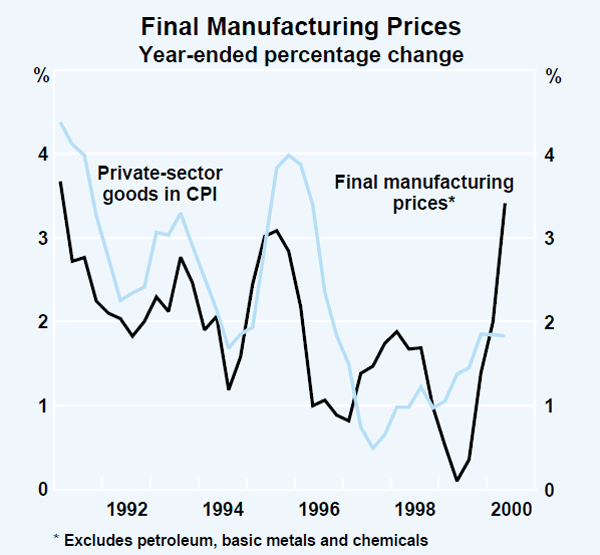
Strong demand in the housing sector fuelled increases in building materials prices in the June quarter, with the increase most noticeable in Sydney. Property and business services prices rose strongly for the fifth successive quarter. Growth in other building materials prices also picked up in the June quarter, but the rise in this series over the past year has been more subdued than that in the house-building series, due to the slower pace of activity in the non-residential construction sector.
A new ABS publication, Stage of Production Producer Price Indexes, presents an arrangement of existing producer price indexes at three stages of production – preliminary, intermediate and final. These indexes confirm that there have been strong increases in prices at all stages of production. At the final stage, producer prices of consumption goods and services increased by 5 per cent over the year to the June quarter, with higher wholesale petrol and food prices being the main contributors. Final producer prices of capital goods have increased due to the higher price of project home prices and exchange-rate induced increases in the price of imports, such as industrial machinery and computer equipment.
Labour costs
Indicators of wage growth have shown divergent movements recently (Table 14). The Wage Cost Index (WCI) for total hours (excluding bonuses), an indicator of movements in average wage rates, increased by 2.8 per cent over the year to the March quarter 2000, which is close to the previous readings for this indicator (Graph 41). Enterprise bargaining outcomes in the early part of the year also suggested little change in the rate of wage growth; new federal enterprise agreements in the March quarter yielded an average annualised increase of 3.4 per cent, unchanged from the previous quarter. In a trend that has been evident for a couple of years, replacement agreements in the March quarter provided for slightly lower wage increases than the expiring agreements.
| Dec 1999 |
Mar 2000 |
June 2000 |
|
|---|---|---|---|
| Wage Cost Index(a) | |||
| Private | 2.8 | 2.9 | |
| Public | 3.5 | 2.5 | |
| Total | 3.0 | 2.8 | |
| Average weekly earnings survey | |||
| AWOTE | 3.0 | 4.1 | 4.5 |
| AWE | 1.6 | 2.8 | 4.0 |
| Executive remuneration | |||
| Base salaries | 4.6 | 4.6 | 4.5 |
| New federal enterprise agreements(b) | |||
| Private | 3.5 | 3.6 | |
| Public | 3.1 | 3.2 | |
| Total | 3.4 | 3.4 | |
|
(a) Total pay excluding bonuses (b) Average annualised increase |
|||

In contrast, the survey of average weekly earnings has recorded a pick-up in growth in average weekly ordinary-time earnings (AWOTE) in recent quarters. Preliminary estimates suggest that AWOTE increased by 4.5 per cent over the year to May, up from the low point of 2.1 per cent reached in the September quarter last year. Being a measure of the wage bill rather than wage rates, this series is susceptible to shifts in the composition of employment. The effect of such compositional shifts, and the volatility of the series more generally over recent years, make the survey difficult to interpret. It is possible, against a background of increasing inflation and a strengthening labour market, that the survey is signalling some pick-up in underlying wage pressures, but at this stage the extent of any such pick-up is difficult to assess.
Recent business surveys have pointed to some upward pressure on wage growth although, again, the extent of such pressure is difficult to gauge. The NAB survey indicates that the growth of labour costs has picked up over the year to June, though the rate of growth in this series is still quite low. Looking forward, the survey also suggests that businesses expect a modest pick-up in growth of labour costs in the September quarter. Both the NAB and the ACCI-Westpac surveys point to higher expectations for wage increases under enterprise agreements. These results may have been influenced by prospects for the wage campaign in the Victorian manufacturing sector, which has recently commenced. Preliminary negotiations between unions and some Victorian manufacturers suggest that new agreements may provide for wage increases slightly higher than those yielded in current agreements. Manufacturing unions are likely to attempt to pursue an industry-wide agreement for other Australian manufacturers in July 2001. In the construction sector, negotiations between unions and employers are now more or less complete. The new agreements have provided for wage increases that are slightly less than those specified in the expiring agreements.
The effect of GST-related clauses in enterprise agreements represents a source of uncertainty in the wages outlook. A number of enterprise agreements incorporate clauses that seek either additional compensation for CPI movements in excess of a benchmark or the ability to review wage increases should the effect of the GST on the price level exceed expectations. At present, however, only a small proportion of enterprise agreements contain a clause of this nature, or clauses that directly link wage increases to movements in the CPI.
Inflation expectations
Survey-based measures of inflation expectations have shown divergent trends in recent months. The introduction of the new tax system has complicated the inflation outlook, while higher oil prices and the lower exchange rate have tended to push up inflation expectations.
Inflation expectations of consumers, as measured by the Melbourne Institute, fell sharply from above 7 per cent in the months preceding the introduction of the GST to 4.6 per cent in July, around the levels recorded a year ago (Graph 42). The proportion of respondents expecting inflation to be 10 per cent or above almost halved in July, following a few months when over one-third of survey respondents had such an expectation. Currently, more than one-third of respondents expect inflation over the next year to be 2–3 per cent or lower.
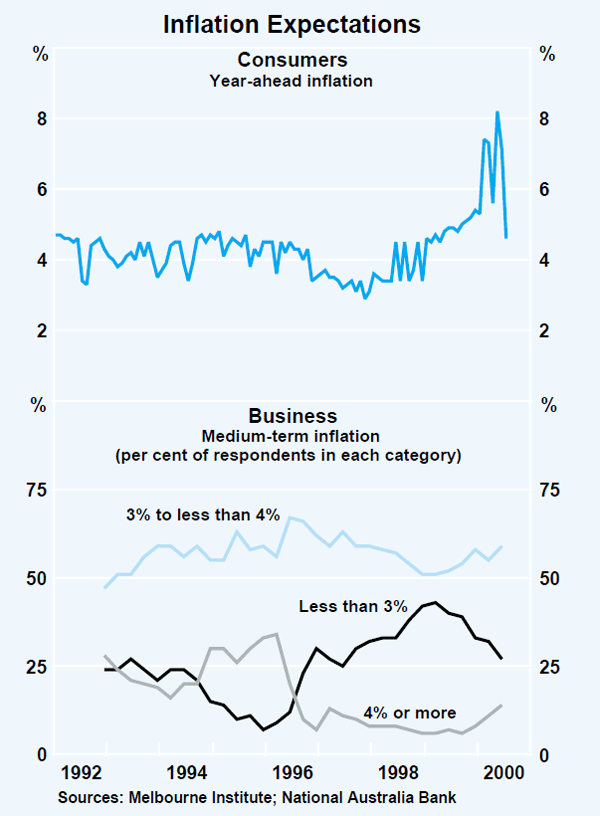
Business surveys have reported expectations of rising inflation in the near term. Following a pick-up in actual price increases over the past year, the June quarter NAB survey reported an increase in inflation expectations in both the short and medium term (Graph 43). Inflation in actual purchase costs and overheads has also risen in recent quarters, and is expected to rise further in the September quarter. The year-ended inflation rates discernible from the NAB survey remain quite modest, despite the expectations for the September quarter covering the introduction of the GST. Responses to a special question indicate that businesses now expect the GST to add less to product prices by the end of this year than they had expected six months ago. The June quarter ACCI-Westpac survey of manufacturers suggests that price pressures are picking up noticeably in that sector, with the net balance of manufacturing firms increasing prices remaining at a high level. Medium-term inflation expectations of businesses, as reported in the quarterly NAB survey, have increased over the past year. A clear, although gradual, shift has occurred in respondents' medium-term inflation expectations, with the share of respondents expecting inflation to be less than 3 per cent per annum declining steadily since early last year.
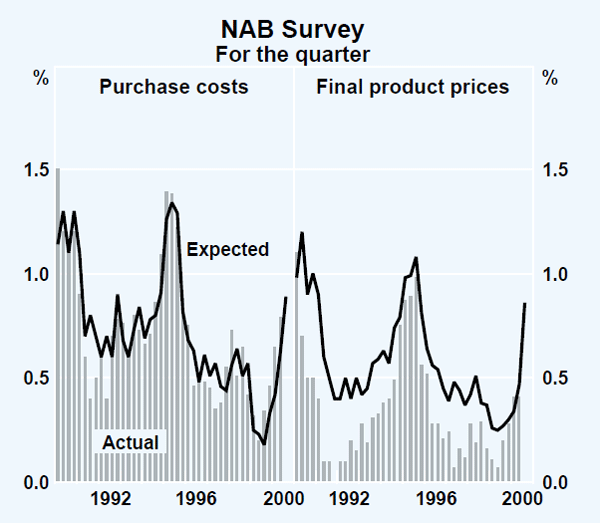
Inflation forecasts of private-sector economists for the year to June 2001 continue to edge upwards (Table 15). The median inflation forecast of private-sector economists for the year to June 2001, as surveyed by the Bank following the release of the June quarter CPI, has increased to 5.5 per cent from 5.3 per cent in the March survey. The median estimate of the effect of the tax package on the CPI over the year to June 2001 remains at around 2¾ per cent (in line with the Government's estimate). Hence, excluding the GST, the median forecast has moved up to 2.8 per cent. The first reading of the median forecast of inflation for the year to June 2002 is around 2.3 per cent.
| Month of survey |
Year to June 2001 | Year to June 2002 | |||
|---|---|---|---|---|---|
| February 2000 |
May 2000 |
August 2000 |
August 2000 |
||
| Market economists(a) | |||||
| CPI | 5.2 | 5.3 | 5.5 | 2.3 | |
| – Excluding GST | 2.5 | 2.6 | 2.8 | 2.4 | |
| Union officials(b) | |||||
| ‘Inflation’ | 3.5 | 4.8 | 5.3 | 4.2 | |
|
(a) RBA survey of financial market economists (b) ACIRRT survey of trade union officials |
|||||
Trade union officials, as surveyed by the Australian Centre for Industrial Relations Research and Training (ACIRRT), have revised up their forecasts of inflation for the year to June 2001 in recent quarters, reflecting the incorporation of the effect of the GST on prices by more respondents. They expect inflation to remain high in the following year, despite the dropping out of the GST effect on the annual inflation rate.
Longer-term inflation expectations of financial market participants, measured by the difference between nominal and indexed 10-year bond yields, have remained relatively stable over the past few months. After reaching a peak of 3¾ per cent in mid January, the implied 10-year inflation expectation fell sharply in the first quarter of the year to a range between 2¾–3 per cent, where it has remained.
Inflation outlook
Inflation pressures have been gradually strengthening, with all measures of inflation now significantly higher than they were a year ago. The CPI increase of 3.2 per cent over the year to the June quarter was slightly above the Bank's target. This was the first time the target has been exceeded since the mid 1990s, but temporary deviations of this nature are allowable in Australia's flexible inflation targeting policy. Measures of core inflation have shown a more gradual, but still quite clear, increase to be running at around 2½ per cent over the latest year, compared with rates of around 1½ per cent at the recent trough.
Economy-wide demand conditions, as well as changes in the international price environment, are important forces underlying the shift in inflation. At the same time, a number of particular factors which have also contributed to recent inflation developments will probably prove to have been of a temporary nature. The most important of these has been the increase in international oil prices. This has been reinforced by the recent depreciation of the Australian dollar, such that the combined effect has been an increase in crude oil prices in Australian dollar terms of around 70 per cent over the past year. As a result, petrol prices at the pumps have contributed significantly to CPI inflation over the year and, to a lesser extent, have probably also contributed to some of the pick-up in underlying inflation measures. Other specific factors to have contributed to the CPI increase over the past year have been large increases in insurance and tobacco prices, much of which were tax-related, and house purchase prices, which have been partly driven by strength in housing demand attempting to avoid the GST (and accommodated by easy credit availability).
But while these factors are unlikely to continue contributing to inflation to the same degree as they have done over the past year, a number of other sources of inflationary pressure remain in place and may strengthen further. Important near-term influences on prices will be the significant increases in production costs that have occurred recently, arising from higher fuel prices, increases in a range of other commodity prices and the effect of the lower exchange rate on prices of imported inputs. These increases in costs are likely to represent a source of upward pressure on consumer prices in the near future. The lower level of the exchange rate, if sustained, is also likely to generate direct upward pressure on prices of imported and import-competing consumer goods.
Of greater importance looking further ahead is the more general influence of economy-wide demand pressures. The economy is now at an advanced stage of its current expansion and has continued to show greater strength than had been generally expected, with real GDP growing at an average annual rate of more than 4½ per cent, and domestic final demand at over 5 per cent, for the past three years. Growth at this pace has exceeded the rate of growth of the economy's productive potential, generating declining unemployment and rising levels of capacity utilisation, and is likely to have contributed to the upstream price pressures described above. While some slowing in the pace of growth in some sectors – such as housing – is likely in the period ahead, there are few signs at present that any slowing in aggregate demand is likely to be particularly pronounced. Overall growth is likely to be at least as high as the economy's long-run potential growth rate.
Wage developments remain an important source of uncertainty in assessing the inflation outlook. Over recent years, growth in wages has been quite moderate, and in most of the available data, this continued to be the case in the early part of 2000. Growth in the Wage Cost Index for the year to the March quarter remained low, and enterprise bargaining data for the March quarter showed no change in the average negotiated increase. Average weekly earnings data for May showed a sharp increase in ordinary-time earnings growth, although the quality of this series as an indicator of wage growth over the short term is poor. With output growth likely to remain strong, labour market conditions will probably tighten further. Since wage claims could also be expected to be responsive to the increase in underlying price inflation already observed, wages growth is likely to pick up in the period ahead, though the extent to which this may already be occurring is difficult to assess.
The June quarter represents the last CPI figure for some time for which the annual increase will not be heavily affected by the implementation of the GST and related tax changes. Preliminary indications are that the implementation of the tax changes on 1 July proceeded smoothly and that the net tax effects on prices were broadly in line with (or possibly slightly lower than) those suggested by prior estimates. Nonetheless, the CPI will show a sharp upward movement in the September quarter and, in year-ended terms, the CPI increase will remain well above the target until the June quarter 2001. For a period after that, in the second half of 2001, the annual figure may then be held down by lagged effects of some indirect tax reductions. Hence, it will be some time before the CPI will provide a completely unambiguous reading of the annual inflation rate unaffected by the tax changes. Moreover, standard measures of underlying inflation will also be affected by the tax changes during this period (see Box).
As has been stated on a number of occasions, the Bank intends to abstract from the price-level effect of the tax changes and will seek to ensure that ongoing inflation remains consistent with the target once the tax changes have been absorbed. Given the uncertainties as to the exact size and timing of the tax effects, this will require careful judgments to be made as to the contributions of tax effects and ongoing inflationary pressures to CPI outcomes in the coming quarters.
The Bank's current assessment is that inflation as measured by either the CPI or underlying measures is likely to be in the upper part of the 2–3 per cent target zone, once these temporary tax effects have passed out of the calculation. This assessment is based on an evaluation of the recent trends in core inflation and likely developments in demand conditions, and takes into account the dampening influence of the monetary policy adjustments since November 1999. The assessment depends importantly on the assumption that there will be no significant second-round wage and price effects arising from the tax changes and that the tax-related increase in the price level does not generate an upward shift in ongoing inflation expectations. While this remains a source of risk, developments so far have been broadly consistent with this assumption. There have been few signs of excessive price increases in response to the tax changes, or of widespread GST-related wage claims.
The risk of a more substantial and sustained pick-up in inflation would be heightened if the economy were to expand significantly more quickly than currently envisaged. Risks working in the opposite direction can be identified as well. A weaker global environment could dampen demand pressures in the period ahead, although that appears to have become less likely recently. Strong growth in productivity may continue to restrain growth in unit labour costs to a greater extent than expected, though productivity growth in the past year has been below that in the preceding few years. Finally, were the exchange rate to rise significantly from its recent low levels, that would also help to dampen inflation pressures both directly and indirectly. The balance of risks around the central forecast appears at present to be such that it is more likely that inflation will exceed the forecast, and therefore exceed the target, than that it will fall below it.
Box: Underlying Inflation and Taxation Changes
The introduction of the major elements of the new tax system in July will lead to temporarily higher CPI inflation in the September quarter 2000, followed by a period of time during which reductions in various taxes flowing through to prices will reduce measured inflation. Once the effects of the tax changes on prices have flowed through, inflation is expected to return to rates consistent with the Bank's target, but there will be a permanent effect on the level of the CPI relative to the path that it would otherwise have followed.[1] Measures of underlying inflation, which are designed to abstract from the volatility inherent in the CPI, cannot remove the effects of the wide-ranging changes to prices associated with the tax changes. Consequently, all published measures of inflation are expected to increase temporarily in the September quarter.
Underlying inflation measures, which, along with the CPI, tend to produce similar average inflation rates over a run of years, fall into two broad categories (Table 1).[2] The first two underlying measures in the table are exclusion-based, with prices that either have a high average volatility, or which are not market-determined, permanently excluded from the CPI basket. The other two measures are based on statistical criteria, which are designed to limit the influence of extreme price changes irrespective of the source. These measures are calculated by excluding a proportion of extreme price changes, but unlike the exclusion-based measures, no judgement needs to be made about which particular items to exclude each period. However, judgement is required as to what proportion of price changes to exclude; the trimmed mean excludes a fixed proportion of items (by weight) at the extremes of the distribution of price changes, while the weighted median excludes all but the middle price change in each period.
| Average since mid 1993 | Year to June 2000 | |
|---|---|---|
| CPI | 2.1 | 3.2 |
| Underlying measures: | ||
| CPI excluding volatile items(a) | 2.3 | 2.6 |
| Private-sector goods and services | 2.2 | 2.4 |
| Weighted median | 2.1 | 2.4 |
| Trimmed mean | 2.1 | 2.7 |
| (a) CPI excluding fresh fruit and vegetables and automotive fuel. | ||
The tax changes will not necessarily affect the CPI and underlying measures of inflation to the same extent. For the CPI excluding volatile items, the effect of the tax changes can be expected to be slightly larger than for the CPI, as the prices of the excluded items – namely fresh fruit and vegetables and automotive fuel – are not expected to be significantly affected by the tax changes. The net tax effect on the private-sector goods and services measure may be somewhat larger, since a greater proportion of the CPI basket is excluded, for which the net price effect of the tax changes is also expected to be negligible. In the case of the two statistically based measures of underlying inflation, the expected relative impact of the tax changes is less clear. Although we have some idea of the distribution of tax-related price changes across different items of the CPI, this is not sufficient to determine whether the effects on the median and trimmed mean measures of inflation will be greater or less than the total effect on CPI inflation. It is the distribution of overall price changes in the CPI basket – the combination of tax-related price changes and persistent inflation – that will determine the precise effect on the median and trimmed mean.
Since all published measures of inflation will be affected by the tax changes, the ABS proposes to calculate a ‘constant tax rate measure’ for the September quarter CPI. In November, the ABS intends to publish the proportion of the change in the September quarter CPI attributable to changes in tax rates between the June and September quarters 2000. The constant tax rate measure can abstract only from the first-round effects of tax changes on prices, arising mainly from the introduction of GST and the removal of WST on final goods.[3] Accordingly, this approach will provide an upper limit of the first-quarter price effect of the tax changes, because it does not take into account the downward influence on prices from reduced transport costs and the removal of WST at intermediate stages of production. However, these second-round effects are not expected to be fully passed through to retail prices in the September quarter, thereby reducing the degree of overestimation. Additional uncertainty in these calculations arises from the assumption that a 10 per cent GST has the same effect on the retail price as a 10 per cent WST, even though the WST is levied at an earlier stage of production and therefore represents a smaller amount of tax for a given tax rate. This provides a possible source of offsetting downward bias in the estimate of the net tax effect.
As has been noted in the Bank's policy statements, the Bank will seek to look through the wide-ranging, but temporary, effects of the tax changes on the published measures of inflation. Monetary policy will be based on assessments of developments in ‘ongoing’ inflation – that is, inflation net of the effects of changes to the tax system. Thus, the conduct of monetary policy in coming quarters will require careful interpretation of the data on price developments and assessment of the various estimates of the net tax effect on prices that are available.
Footnotes Box
Statement 3 in Budget Paper No 1, 2000–01 Budget Papers presents estimates by the Commonwealth Treasury of the effect of the new tax system on prices. [1]
See ‘Measuring ‘Underlying’ Inflation’, Reserve Bank of Australia Bulletin, August 1994 for more details on the concept of underlying inflation and the definitions used here. [2]
See Price Indexes and The New Tax System, ABS Cat No 6425.0 for further details. [3]